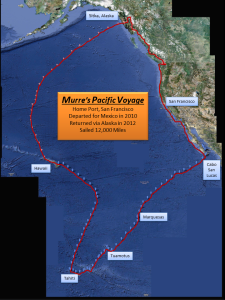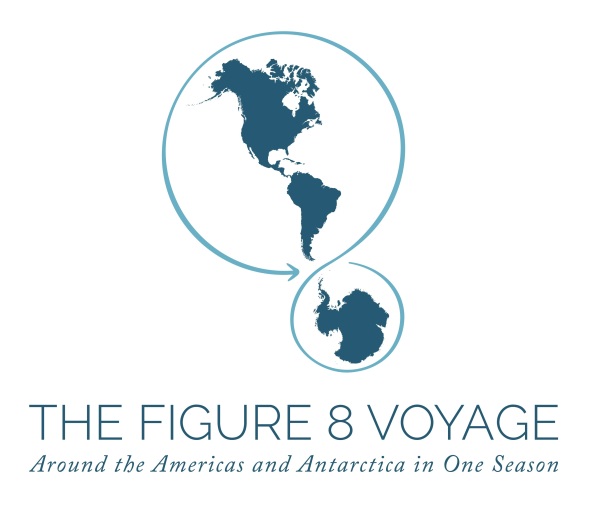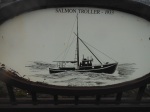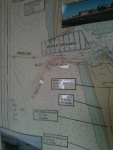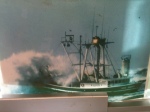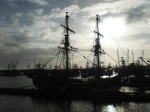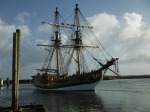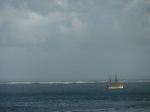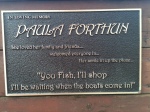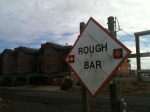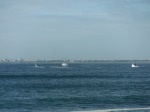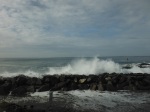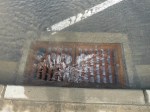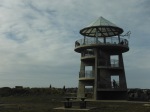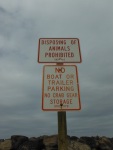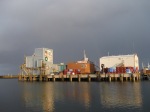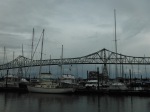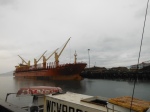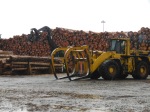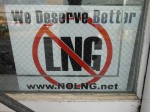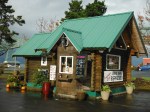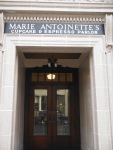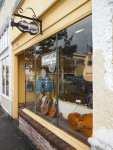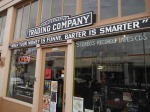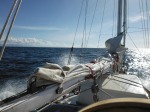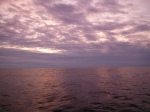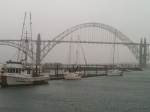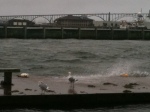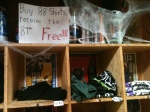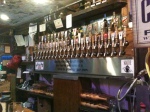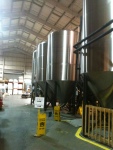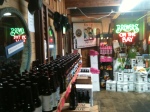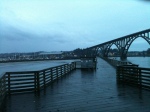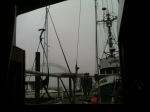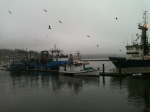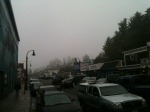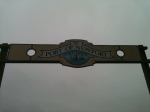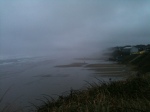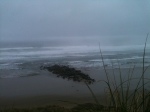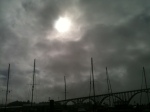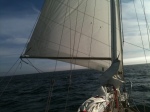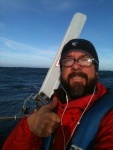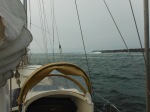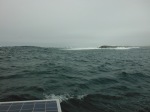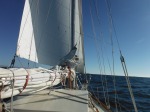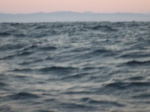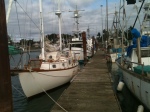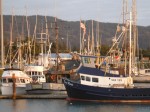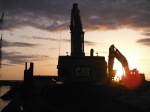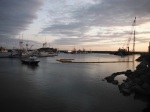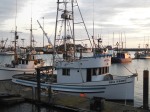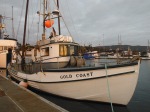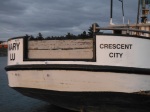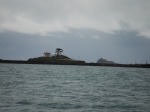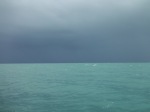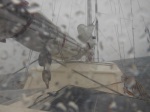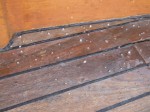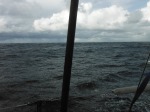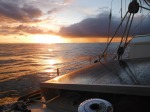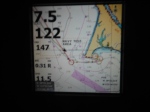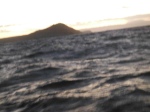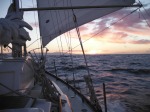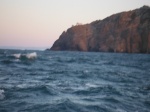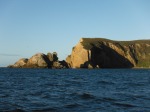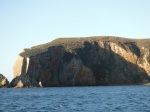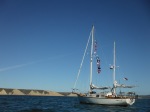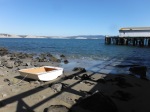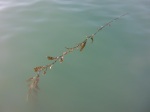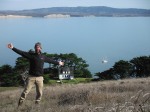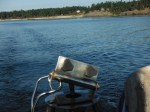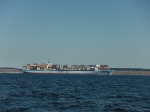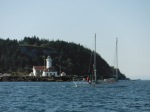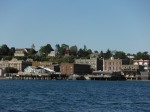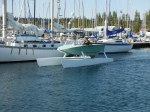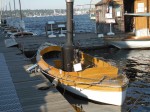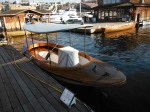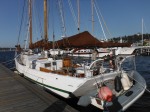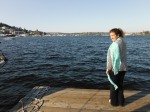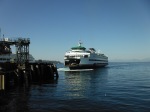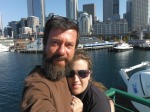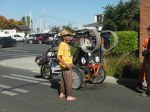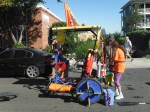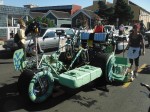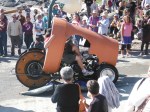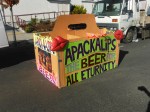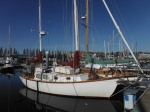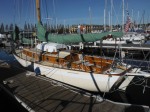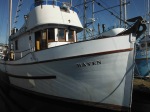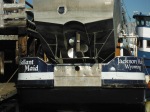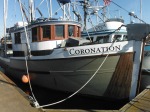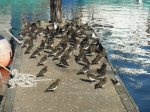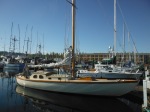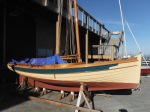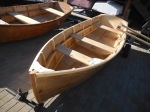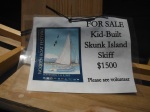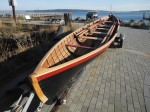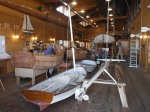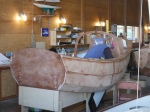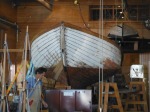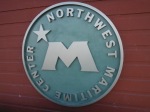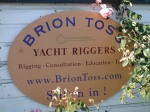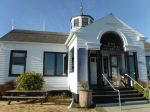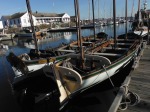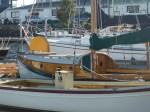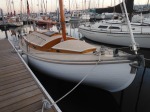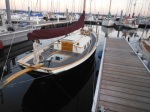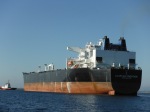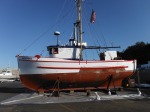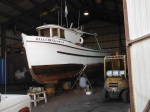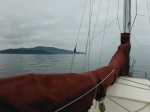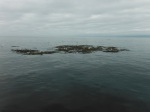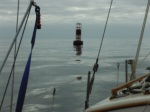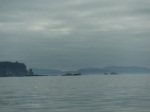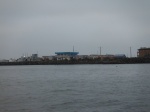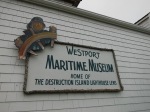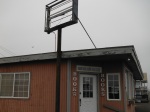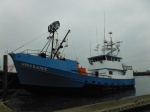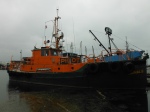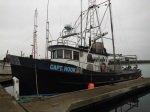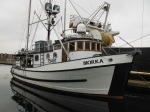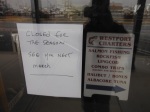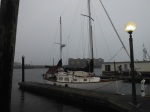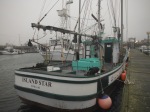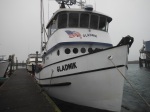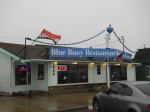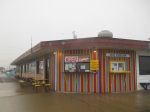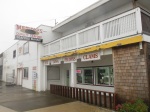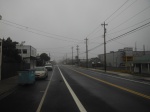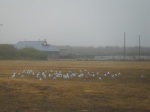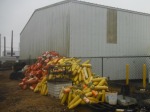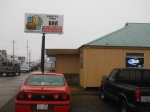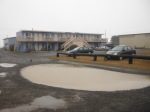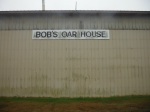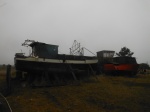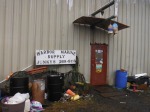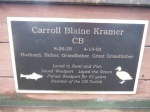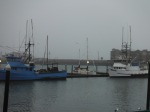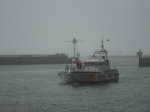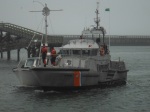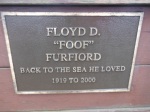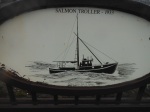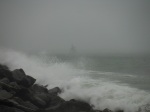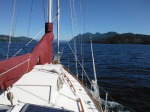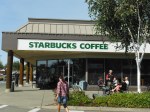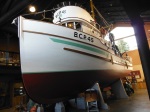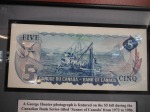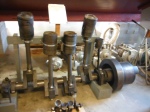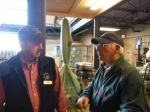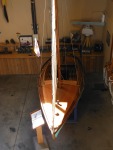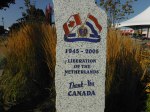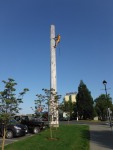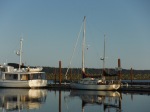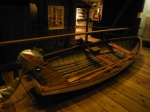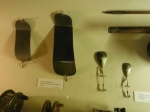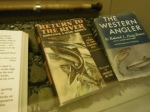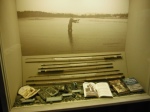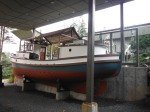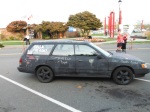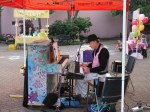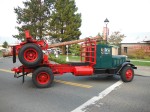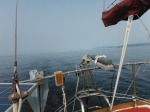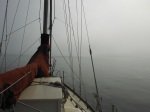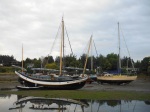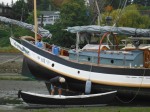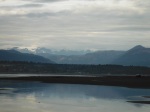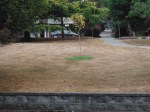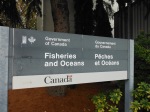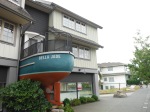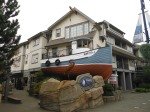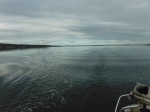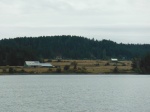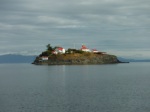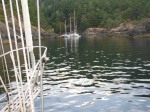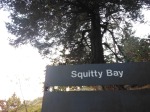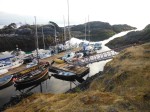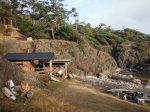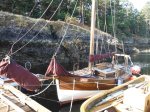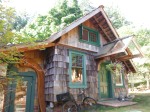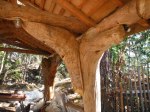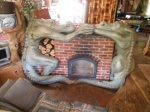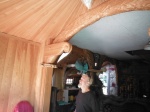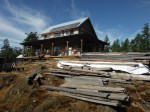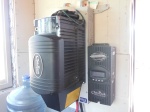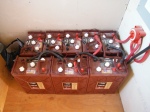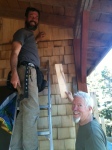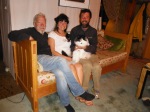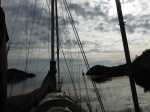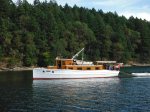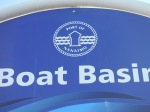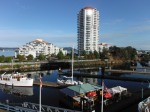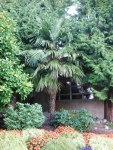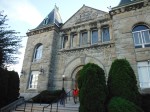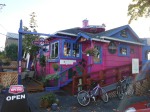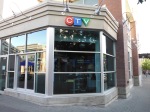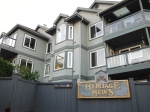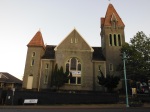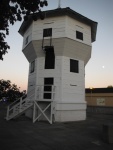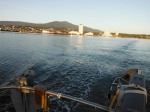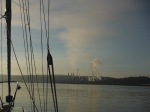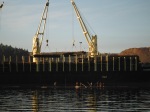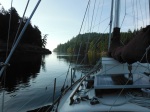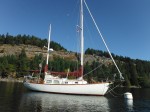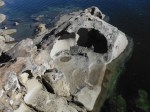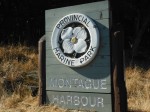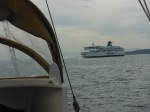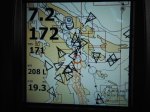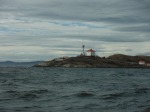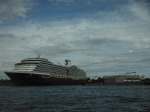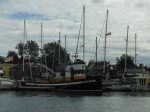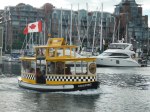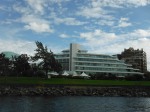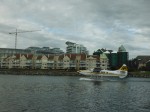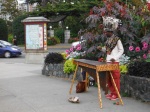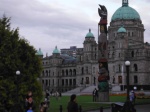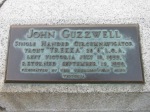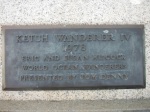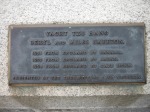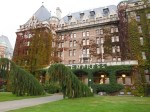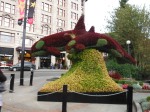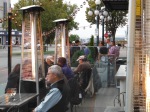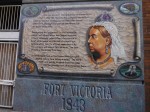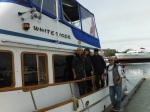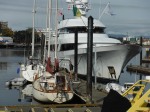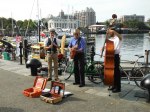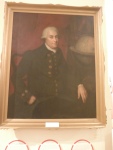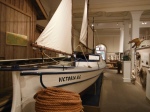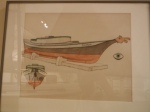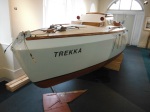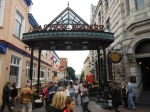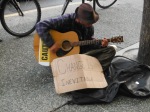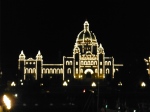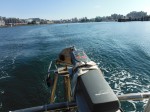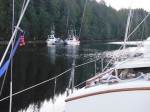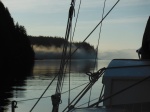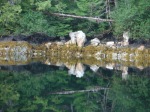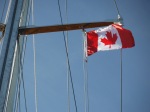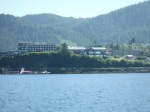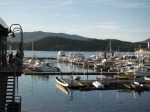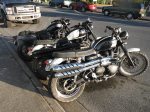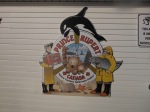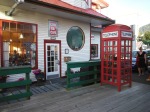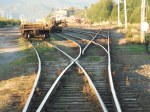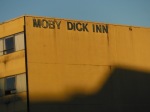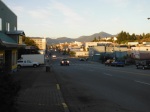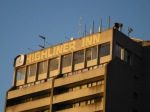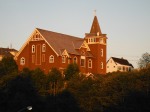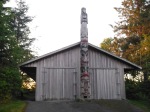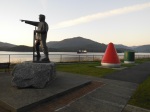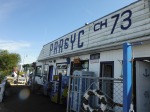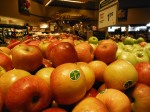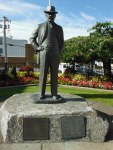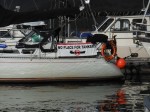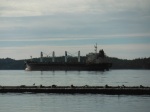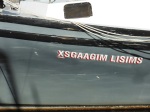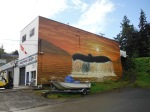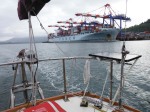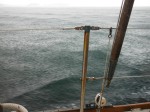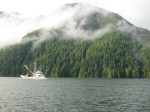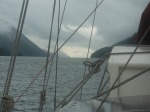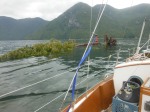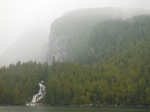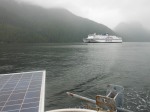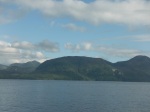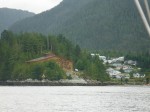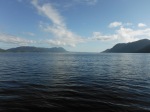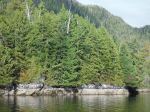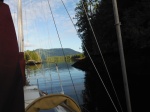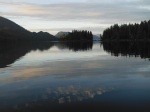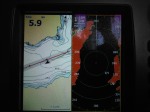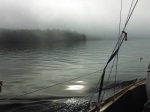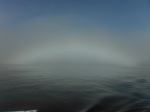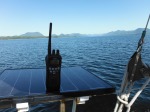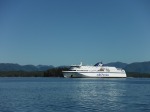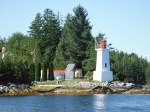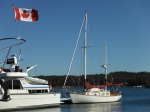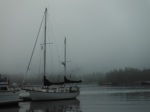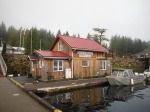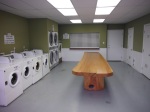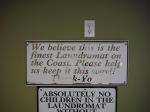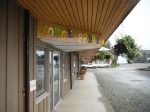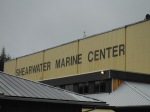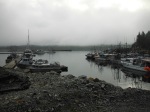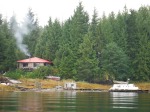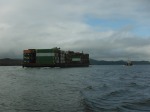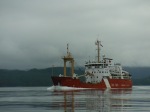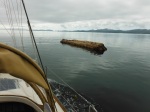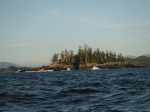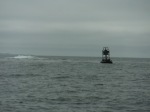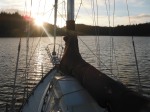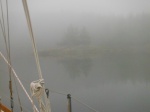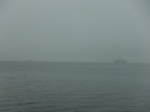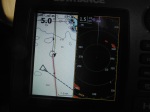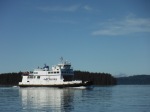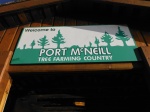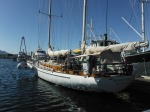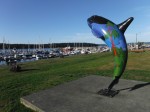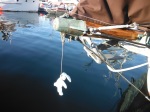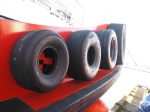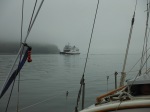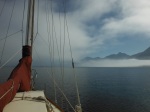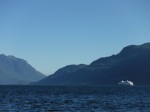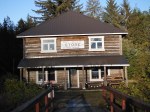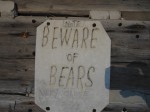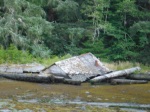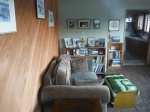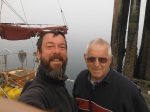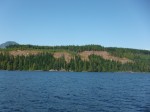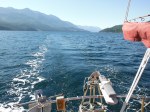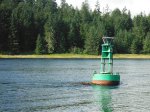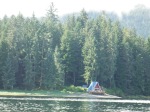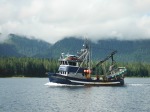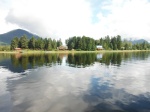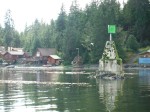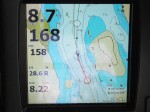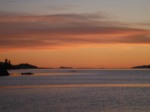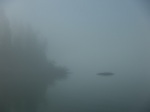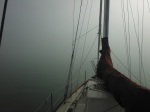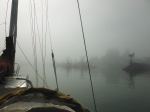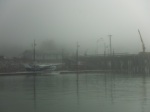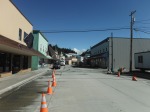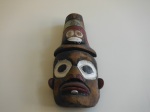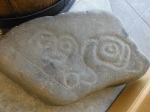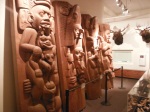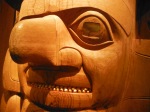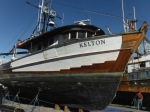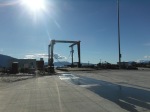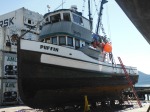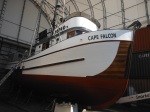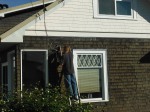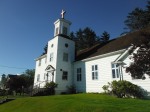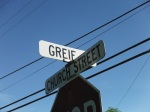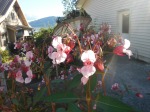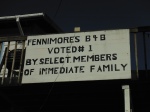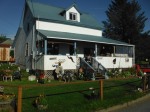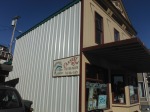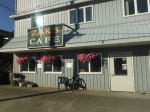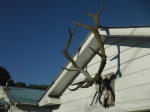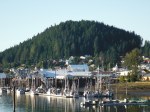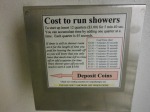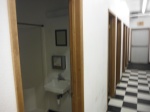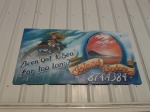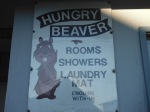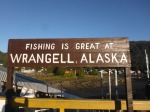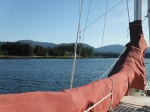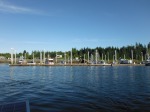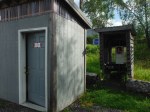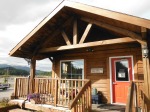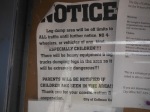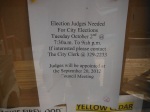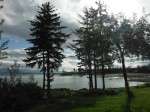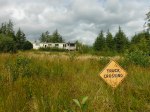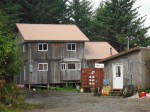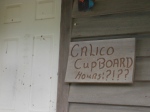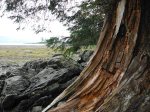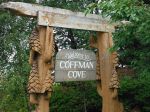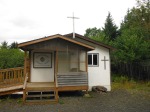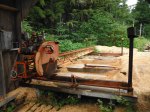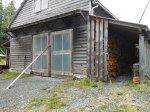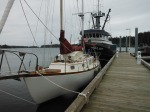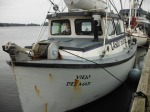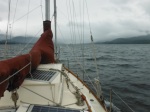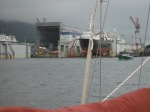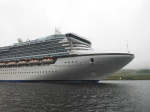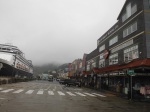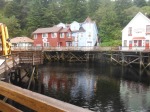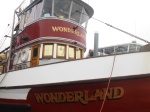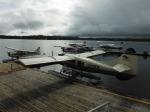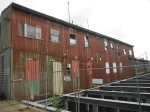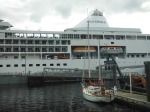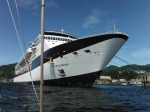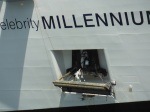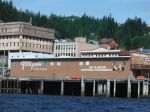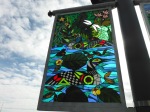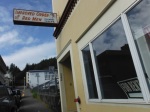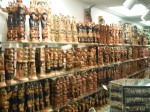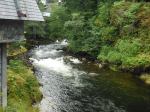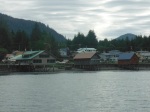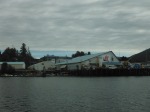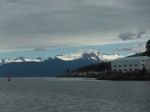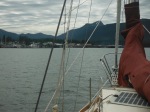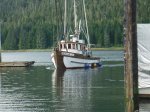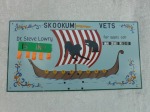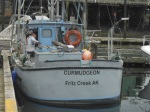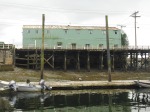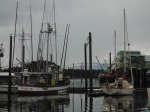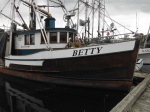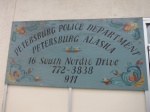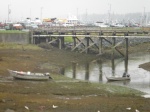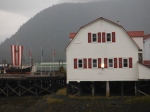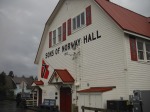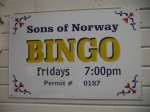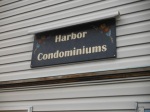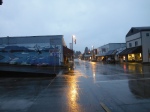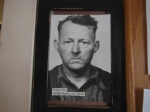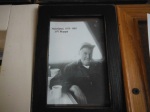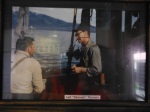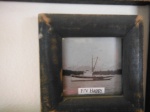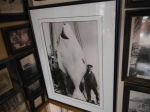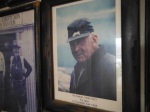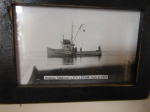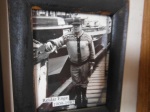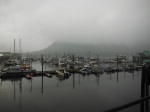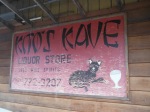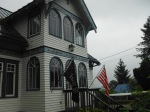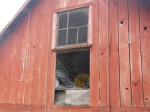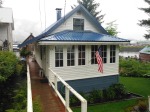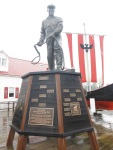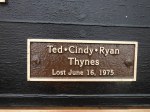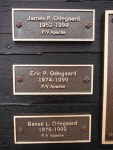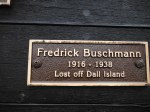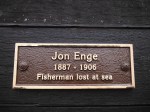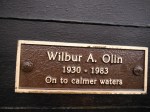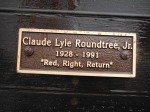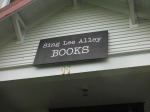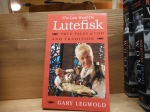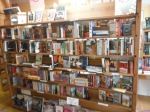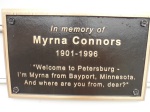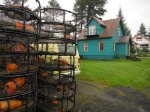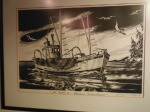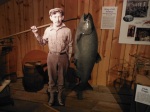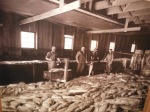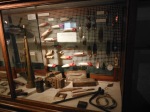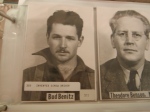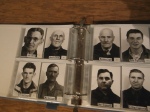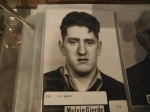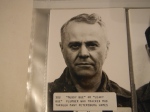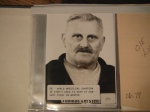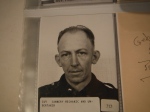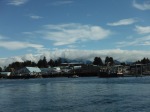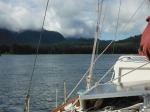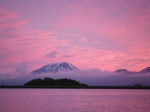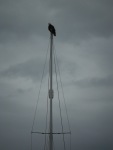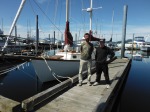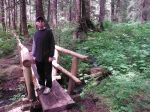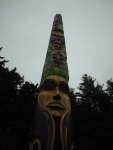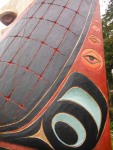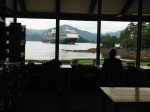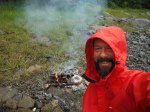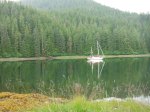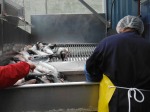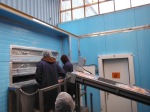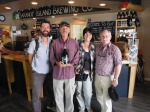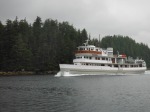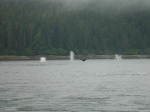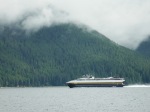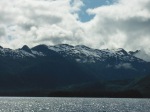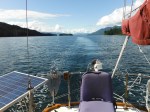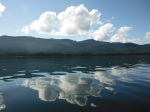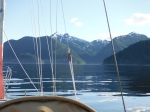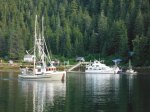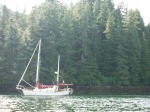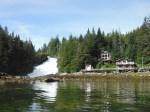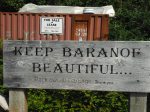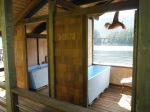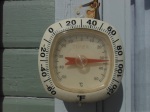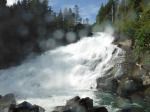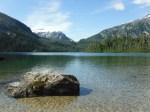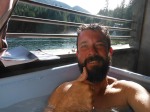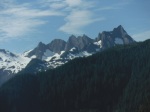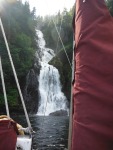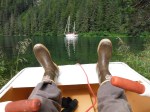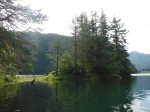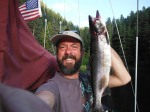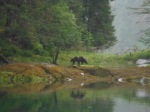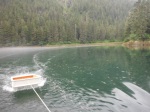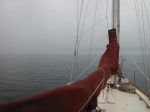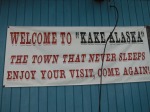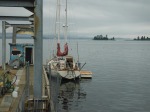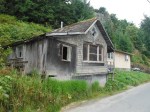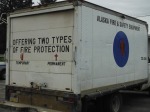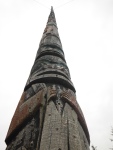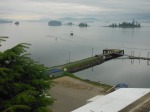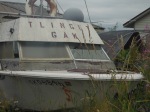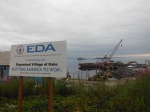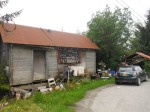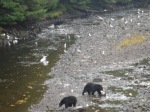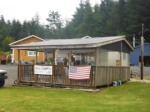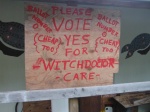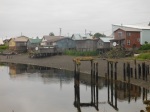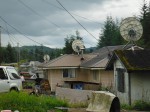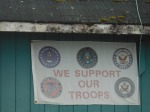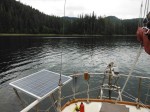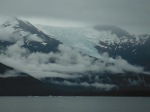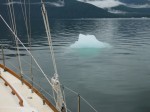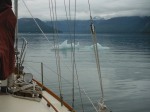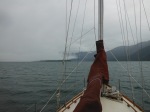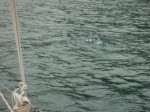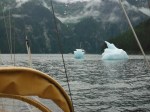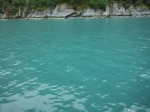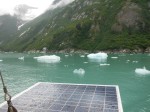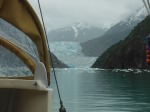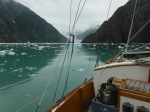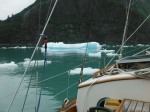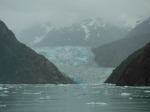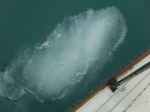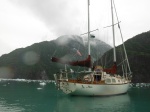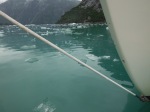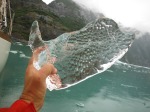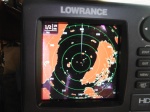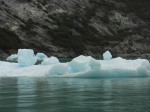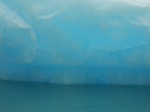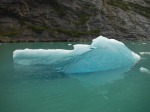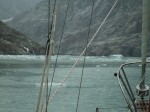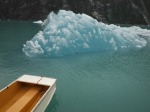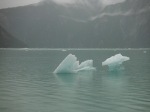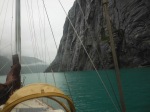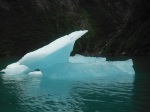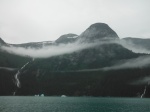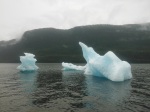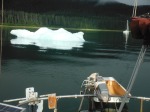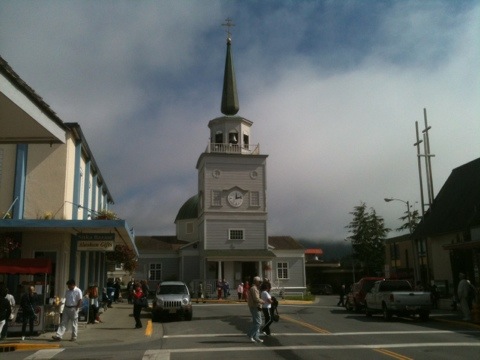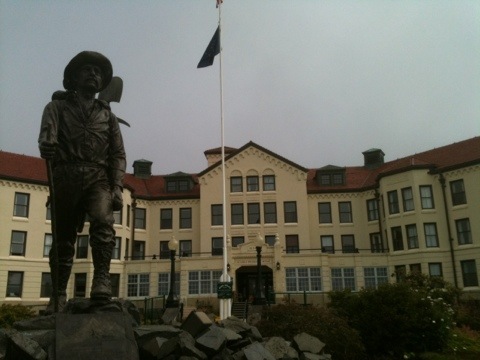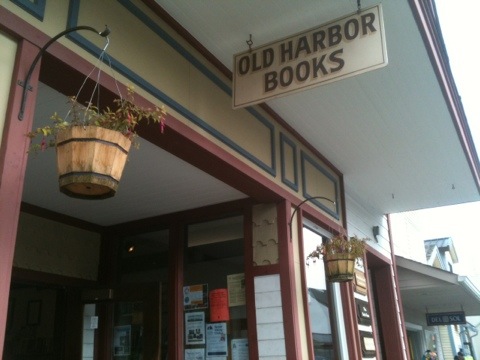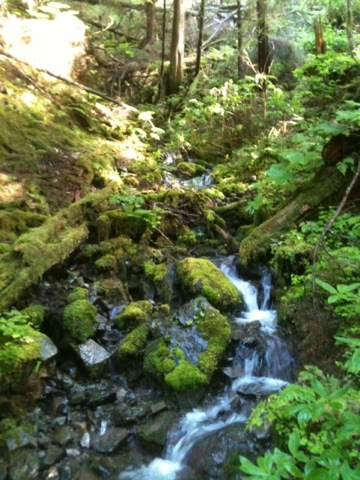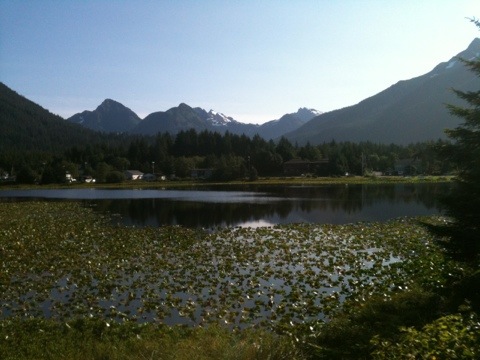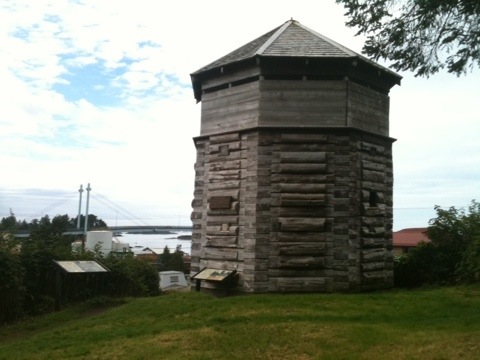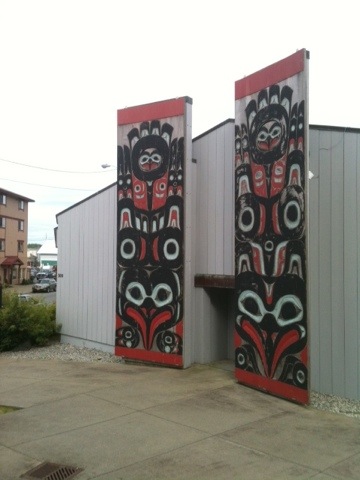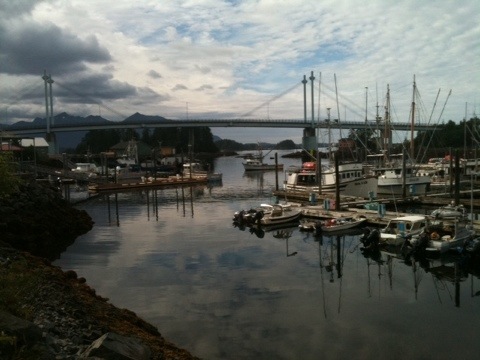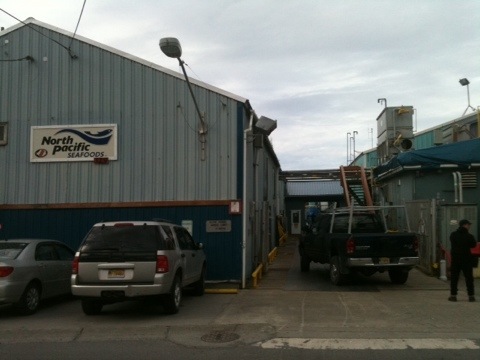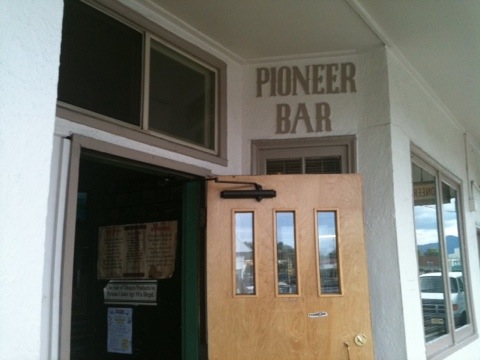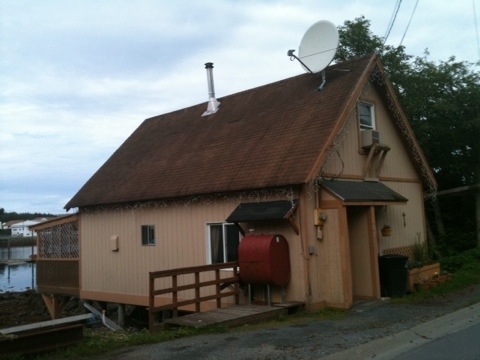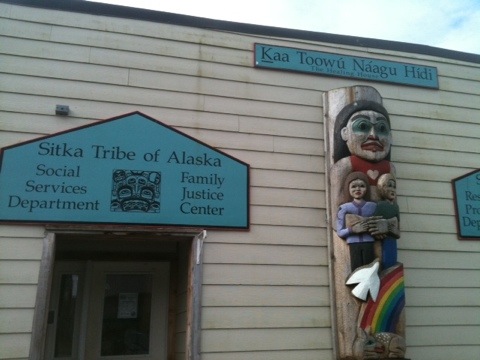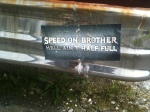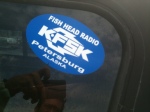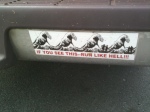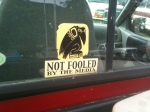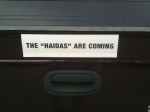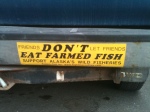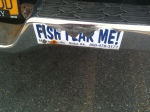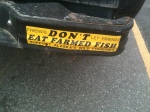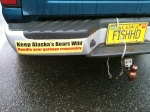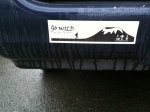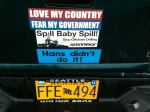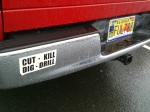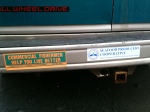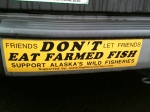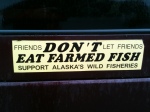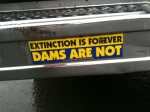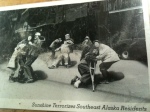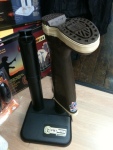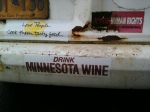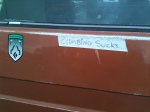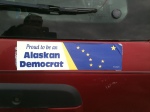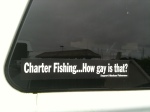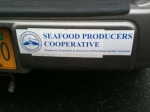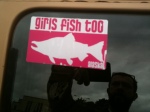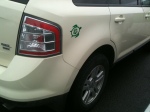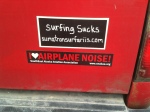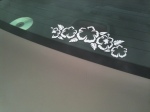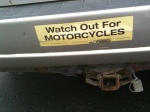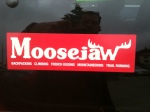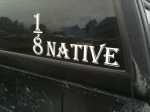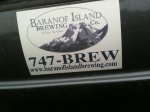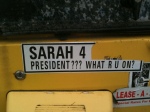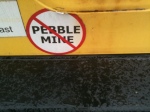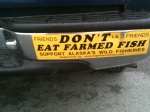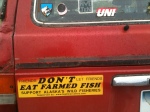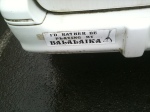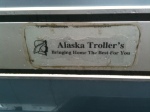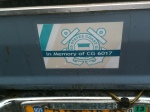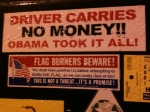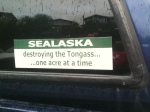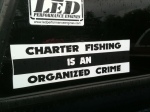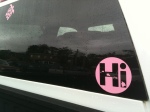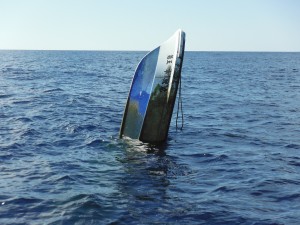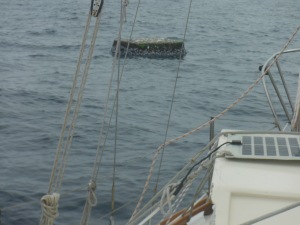Introduction
Murre and the Pacific chronicles a two-year solo cruise of the biggest ocean on the planet.
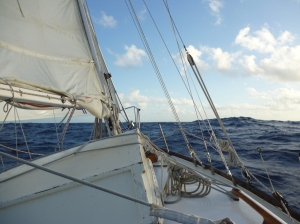 Murre and I departed San Francisco in October of 2010 intending to explore the Sea of Cortez during that winter before reaching for Hawaii and then home, a one-year cruise per plan and per special arrangement with the wife, whose honest enjoyment of boating does not extended to long separations from “hot and cold running water under pressure.”
Murre and I departed San Francisco in October of 2010 intending to explore the Sea of Cortez during that winter before reaching for Hawaii and then home, a one-year cruise per plan and per special arrangement with the wife, whose honest enjoyment of boating does not extended to long separations from “hot and cold running water under pressure.”
While in Baja, many sailors I met talked of their spring migrations to the Marquesas. The where? A little research put these islands in French Polynesia, enticing close to Tahiti. Tahiti! What sailor could resist that exotic call? Not this one.
I practiced my pitch for days prior to a weekend visit from the wife in Cabo. One evening by the pool and in the company of two margaritas I began the broach.
“I’ve been thinking of visiting the Marquesas before the leap to Hawaii,” I said.
“The what?”
I explain.
“How long will that take?” she asked.
“A month to get there but an extra year to get home.”
She pondered for a moment. Which from an infinity of justifiable objections would she choose? Had I anticipated them all?
“I think you should do that,” she said.
And I did.
In total this now two-year exploration of the Pacific entailed visits to many of the islands and atolls in all three groups of French Polynesia, all the main islands of Hawaii, and Alaska’s Inside Passage from Sitka and the Sawyer Glacier all the way to Seattle, all solo and in a small boat.
One unique feature of the story is its thoroughness. In particular, ocean passages were logged to this site daily, and reportage went far beyond the usual (position, wind, waves) by attempting to share in article-length detail what it is like, what it feels like, to cast one’s fortune with the sea.
Alas, the organization of a blog is not that of a book, and so for those wishing to navigate the content themselves, a CHAPTERS category has been added to the right sidebar, which contains eight Episodes in blessedly correct chronology.
The reader will quickly notice that none of the posts from sea contain pictures, this due to a communications system whose low bandwidth disallowed graphical files (except once). Pictures were taken by the score, however, and were posted to the blog later and organized by episode in the PHOTOS tab. The last leg from Hawaii to Alaska was captured in eleven VIDEOS produced roughly every other day while on passage.
For those wishing to forgo the tedium of every day’s life at sea in favor of a quick dive into the action, this list may provide a start:
- An Unexpected Visitor (from Murre to the Marquesas)
- A Short Conversation with the Doldrums (from Murre to the Marquesas)
- A Lake Inside the Ocean (from Cruising French Polynesia)
- Night Crossings in Hawaii (from At Home in the Islands)
- Catching and Preserving a Very Large Fish (VIDEO from Into the North Pacific)
- Wing and Wing plus, “Was that an Otter out Here?” (VIDEO from Into the North Pacific)
- Sobering Effects of Falling Overboard (from Into the North Pacific)
- Ice with Everything at the Sawyer Glacier (from Along a Fir Lined Coast)
Lastly, the story doesn’t end with Murre’s return to San Francisco in 2012.
To learn about the next adventure, please visit The Figure 8 Voyage.
Return
November 11, 2012
Next morning I wandered the steep bluffs of Point Reyes, blood exploding the disused veins of my atrophied sailor’s legs and my tiny sailor’s lungs pulling hard for air. Sea lions jousted on the beach. Sparrows scattered from the trail to hide in the dry grasses and in a pine, the call of a blue jay. Even at ridgetop winds were calm, the open sky letting down such warmth that I thought to remove my sweater, but did not.
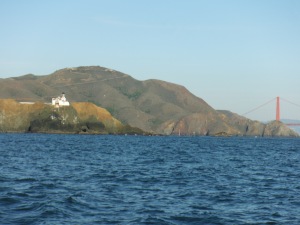 The pressure off, having got below the northern winter, I could remain here a few days, I thought. It was tempting. But forecasts indicated southerlies would fill in overnight, making Drakes Bay untenable.
The pressure off, having got below the northern winter, I could remain here a few days, I thought. It was tempting. But forecasts indicated southerlies would fill in overnight, making Drakes Bay untenable.
At eleven I moved to weighed anchor for the last time. It stuck hard in the mud. Murre shared my unwillingness.
Now wind was light from the southeast, then east. Then it faded. We motored slowly along this coast of long acquaintance, past Limantour spit and the Palo Marin hills, past Bolinas town and Stinson Beach. As Pigeon Point lighthouse came into view, so did the Golden Gate Bridge–just the tip of its north tower. Then the carnelian sky scraper that houses Bank of America. Then the bone-white Trans America Pyramid. Small boats scurried about dropping crab pots over dangerous Potato Patch Shoal that today shone like a lake.
Then the turn, the bridge dead ahead, rocky Alcatraz behind and the green hump of Angel Island beyond.
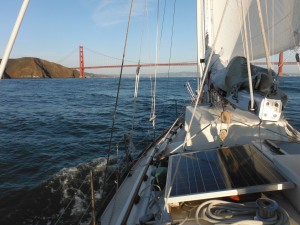 I understood there would be no one to greet me. My arrival could not be predicted, even by me, until I’d swung behind Point Reyes, and weeks ago my wife had booked her travel. As Murre and I approached the Gate, she snoozed in a window seat, the plane carrying her to a conference in San Antonio. It could not be helped, this solo return, and I had told myself it was most fitting. Still, I wondered if an approaching tug was a fire boat rushing to shower me with congratulations, or maybe that excursion boat on a parallel course was lined with my friends come to offer escort. Did I know the couple gazing down from the bridge?
I understood there would be no one to greet me. My arrival could not be predicted, even by me, until I’d swung behind Point Reyes, and weeks ago my wife had booked her travel. As Murre and I approached the Gate, she snoozed in a window seat, the plane carrying her to a conference in San Antonio. It could not be helped, this solo return, and I had told myself it was most fitting. Still, I wondered if an approaching tug was a fire boat rushing to shower me with congratulations, or maybe that excursion boat on a parallel course was lined with my friends come to offer escort. Did I know the couple gazing down from the bridge?
The sun, low and golden, sank behind the Marin Headlands as we tucked into Richardson Bay. We motored the marked channel toward an arranged slip in a marina Murre knew well. I moved forward to ready fenders and dock lines. I stopped. Back at the wheel I pointed Murre’s head out into the bay. I dropped anchor off Cone Rock. I sat in the cockpit. As night came on the starlight of the city sparkled like diamonds.
end
Grays Harbor to Point Reyes–PHOTOS
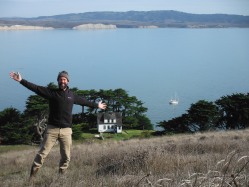
Below are a few photographs recording the time Murre and I spent along the Oregon, Washington, and then California coasts, including waylays in Grays Harbor, Astoria, Newport; the Crescent City fly-by, and finally anchor down in Point Reyes’ Drakes Bay.
It may be interesting to note:
Grays Harbor: the wall chart on which the Coast Guard lays out the geography of the harbor bar (Middle Grounds, Slop Hole, Red Line, Green Line, etc.) in a way that is typical of all the harbors of the coast; the Lady Washington looking so small in the offing; the bar observation tower.
Astoria: the long, high bridge reminiscent of San Francisco’s Bay Bridge; the log ship–all along the coast ships like these were being loaded to the very brim with logs bound, I was told, for the pulp mills of China–two departed the Columbia while this one took on her wood.
Newport: the lovely, arching bridge and that great salvation known as the Rogue Brewer, whose winter ale, Mogul, did much to buoy my spirits. Here also met Kimber and Mike on FREEBIRD (behind Murre at the transient dock), heading south for Mexico and beyond–the only other cruisers I met after departing Sitka. So I was not the LAST boat to escape the North Pacific.
Crescent City: well, the pile driver, of course, and the hail shortly after departure, and that strange turquoise water.
Point Reyes: it starts with the snap of the chart, Murre’s course and her bee-line in…
CLICK TO ENLARGE.
A Point Reyes Homecoming
At eleven that night I gave up. The pile driver and rock mover continued their work under artificial light bright as a welding torch. Boulders for the new jetty dropped from the maw of dozers with a seismic thud; the pile driver kathunked its piles–activities not heard so much as felt through the body as I lay in my bunk searching for sleep. At eleven I rose. I quit Crescent City Harbor, walked across the road and took a room at the Super 8 Motel. The sheets were surprisingly soft. I fell immediately away and through windows wide open heard nothing until the alarm at three.
All that day had been sunny with a crisp north wind but now the American flag above the harbor, big as Texas, flew straight out from the south and a light rain fell. Back aboard Murre, I listened again to the weather forecast, and again heard its call for northwesterlies all night and into the weekend. The rock mover was silent and the pile driver, though active, drove no piles. I crawled in my bag and slept until dawn.
Now the rain had stopped. Wind continued from the south but seemed to be easing. I started the engine; Murre and I were underway, passing Round Rock, the harbor sentinel, by eight. Here the ocean turned a milky turquoise, reminding at once of the bluey-green waters of Tahiti and the silted greens just below the Sawyer Glacier, pleasant memories both, but quickly tempered by the lead sky that, within the hour, covered the deck with pea-sized hail.
All day the sky squalled but less and less so as we pushed offshore. By afternoon the south wind had turned sharply west–almost but not quite sailable. It died with sun down and was not replaced. Cloud vanished entirely. The Milky Way shown, a broad avenue. At first Orion reclined upon the coastal ranges, but slowly he rose to stand, arms wide, as the night approached its zenith.
I slept in 20 minute intervals as Murre swept out and around Cape Mendocino. Large, round and knee-like, this cape is, in fact, the joint at which California’s coast makes its turn from south to southeast. Among cruisers it is known as a junction of a different sort–it is the barrier below which weather markedly improves. “You start pealing off sweaters and long underwear,” said one sailor I met at a party in Sitka.
True to form, next morning brought a sky of pinky, cottony cloud reminiscent of the tropics. As the day warmed I did peal off fleece (though made no such move at the long underwear). Advancing squalls could be counted on the fingers of one hand, and none advanced on Murre.
But we were not out of it–not yet–and by way of reminder, the swell. For hours I watched from under the cuddy as trains of great waves, the result of some northern storm, approached from the west to pass endlessly under Murre. These were “mature” waves, rolling hills and deep valleys, no longer wind-driven but moving under their own power, an inertia of such mass that once in motion their roving could only be halted by the rock wall of a continent. How to describe such feats of nature? As big as a three story houses. Long as city blocks. Their interiors were bunkers. From their crests I looked down as if peering over a cliff edge. Regal, magisterial, haughty, aloof. Mountainous. Alien.
Wave speed is a function of wave size–bigger is faster. Thusly, tsunamis travel the deep ocean at hundreds of miles per hour, only slowing and piling as they reach shore. But speed can be a matter of perception, too, and these waves, these jumbo jets of the sea, appeared equally ponderous and slow as they rose into the air, though to my reckoning they were making thirty miles per hour to Murre’s five. Steep enough that their tops would have crashed dangerously in a stiff breeze, but without such aid they were resigned to flinging their spray straight up.
All day radio announcements from the Noyo River Coast Guard unit warned of fifteen foot seas breaking over the bar at Fort Bragg and ended the message with “Mariners are requested to call this station before attempting entry.” But such heights seemed impossibly diminutive; staring up from the cockpit it looked like these summits rose above Murre’s main mast at 45 feet. Late in the afternoon I got the winning image: in shape and size like the great sand dunes of Saudi Arabia, but blue and heaving.
That night we approached Point Arena without having seen a boat or a ship since leaving Crescent City, so just after sun set I began sleeping in 30 minute intervals–purest luxury. When I rose to check course and position, I saw white lights occulting along the coast to the west, the headlamps of cars traveling Highway 1’s winding path. The predicted northwesterly wind began to fill in after midnight. I rigged the jib pole and opened the head sail, but greedy for speed, eager to make my destination, I throttled back on the engine only slightly. At Point Reyes I would meet my wife, but only if I was on time.
In the early morning an announcement on the radio from the Bodega Bay Coast Guard–an emergency beacon had been activated three miles due west of Bodega Head; mariners in the vicinity were requested to keep lookout and assist in search if possible. The announcement repeated every twenty minutes, “Pan Pan, Pan Pan; at 0230 local the Coast Guard has received an emergency distress signal at coordinates…etc.” Murre was the only vessel in the quadrant, much less the vicinity, but we were ten miles out and ten miles south. In such a sea and headwind it would take three hours to climb back to the position of the signal. And it was a moonless night. I delayed. Should I respond? Surely the Coast Guard was acting–it was their role–but the repeated radio calls made no such mention. I imagined Murre in similar straits. I was reaching for the radio when I saw the first helicopter astern, its red light flashing, its search beam moving over the waves. Murre and I continued on.
Dawn and Point Reyes a black hulk on the horizon. Then sun rise over the city as Murre rounded into Drakes Bay, dropping anchor off the long-shuttered Point St. Joseph fish pier at just after eight, 48 hours after departure.
Home. Two years and two months away, but home now.
The day grew big and blue. The crescent of bay and its sandy beaches folding familiarly around. Fawn colored hills cut by butter yellow cliffs. The high ridges a smoky green of Doug fir. In the far distance, Mount Saint Helena. Nearer in Mount Vision, Mount Wittenberg, Mount Tam. All places I had hiked year upon year. I have been a San Franciscan since 1989, but it’s in this countryside that I left my heart. More than the next day’s return under the Golden Gate, this was the coming home.
My wife arrived at noon. We walked the paths of the point as we have always walked them, single file, she in front. We talked casually as if today was any Saturday afternoon. Often I paused to look down at Murre, anchored below a shock of cypress, tugging gently at her chain. I had not anticipated such pleasure. It still surprises me.
end
Post Card from Crescent City
After Grays Harbor, Murre and I were held in Astoria for four days, and then another twelve in Newport. All rain all the time and winds, strong or promising to be strong, from the south. In Newport, fourteen inches of rain fell in the final three weeks of October. Gale-warning flags flew straight out above the Coast Guard station morning after morning.
Our escape came last Monday at noon. Two days of sailing and motoring on a dry, almost cloudless, mostly light northwesterly, a wind we’d waited for a month, put us into Crescent City, California at midnight. The watchman called on the radio as we entered, directed Murre to a slip with his flashlight, talked my arm off until half past one.
While he talked, my mind wandered. Five hours out and twenty miles offshore wind had come on strong, bringing a low fog. Without moon or stars, visibility drew close and phosphorescence became the only source of light. Whitecaps burst like ghosts for 50 yards around with nothing to illuminate them but their own energy. When Murre crashed a wave, her spew flew out, a glowing veil. Water or sky or the difference between was but inky blackness. Or no, it could not be seen–except by its effect. Murre heaved and gyrated on a force invisible. Then suddenly, three straight lines of phosphorescence charging the boat, pale tubes like the trace of torpedoes. Reaching Murre, the tubes split, two charged the bow and one circled the stern. Dolphins, come to play in the boat’s wake. For minutes on end they raced eerie paths of arcs and spirals in the near water, now spouting, now charging again into the crest of wave. Never did I see the body of a dolphin, a fin or an eye, only the round and glowing wake left by their movement in the otherwise featureless, heaving water.
Crescent City was a mistake. The Japan tsunami of 2010 sent, some nine hours after its initial shock, a surge wave to this harbor that wiped out the marina. Docks disintegrated; boats sank. Only now, this week, is reconstruction getting underway in earnest. I came here for fuel and sleep. Only the former is accessible. Crews on pile drivers and drills and rock movers work round the clock near the hodgepodge of slips, reconstructed from the post-surge drift, that house the fishing fleet and Murre. I am typing this while wearing ear plugs and still I can hear the kuclump kuclump kuclump of the pile driver through the hull of the boat. What a thing it is to crave sleep, having missed it recently and knowing its near-future short supply.
We depart at 4AM for the 270 miles (two and a half days, more or less) to Point Reyes.
Weather Bound
October 10
All the next day and into that night the storm blew from the south with a will. Then before dawn the rain stopped and the song in the rigging changed in tone but not intensity. From my bunk I could feel that the tug of Murre at her dock lines had shifted its rhythm, and I rose to a wind blowing strongly from the west. A sailable wind. My heart beat faster until the radio reported that the Grays Harbor bar continued to throw fourteen-foot seas and the Coast Guard had closed it to all but commercial traffic.
In port now, having arrived overnight from the up-bay town of Aberdeen, was the Lady Washington. She was a heavily built, 100 foot square rigger, a replica of the ship used by Captain Robert Gray, discoverer of this eponymous harbor in 1792, to explore the Pacific coast. Years ago in San Francisco I had spent an afternoon aboard the Lady while she maneuvered in mock battle with another replica, the Hawaiian Chieftain, and remembering her home port was part of what attracted me here. That she had been absent when Murre and I arrived failed to surprise (exhibition ships usually winter in warmer, dryer climes where they can continue to exhibit comfortably), but it had been disappointing, as it was now to learn that she was at the fuel dock this early morning, engine running, crew on deck, the captain in the master’s shack paying for his load of diesel.
“Departing so soon?” I asked as he passed, a bear of a man whose thick, red beard failed to hide his youth; when he smiled, he looked all of twenty-five.
“Got a weather window for San Francisco,” he said without stopping. His crew donned foulies and harnesses. The Captain moved quickly to the large tiller on the poop and began shouting orders. I hustled to the bar observation tower at the end of town to watch her pass. The sky had cleared but now a wave-born haze lay over the water. The Lady tracked directly out the bay’s center without incident, but at the outer jetty, where the open ocean meets the bar for the first time, she shook violently, appeared no more substantial than a box of matches. Twice she dove clear out of sight, falling over the back of a big growler as if toppling off the edge of the world, but always she rose again, appearing to have taken no water over the bow.
No water over the bow, I thought, waves are not breaking. Murre could depart today too.
***
That the Oregon and Washington coast carries danger to new heights is a truth universally recognized by those who cruise the east Pacific. During summer months, prevailing winds come strongly from the northwest and west and create, between Cape Flattery and Cape Mendocino, 700 miles of cliffy, boulder-strewn lee shore. In the winter, the flow is reversed but is equally as pressing. Sheltered bays with all-weather access are non existent, and the difficulty of its widely-separated river harbors serve to cloak this piece of water in a mystique approaching the evil. To those who have sailed it, surviving its violent seas was managed by the skin of teeth and the grace of god; those who have been spared the pleasure seem always to know someone who nearly bought the farm. One sailor I spoke with in Victoria said he’d made two passages between Seattle and San Francisco. “Both were stormy–unbelievable waves, everyone sick; never again!” Now he flies to the north in summers and charters from a company in Puget Sound.
Knowing its reputation I have been monitoring this coast since Hawaii. Day after day for months weather maps have shown winds sweeping down, colliding with large Cape Blanco and Cape Mendocino, larger still, causing regular accelerations in excess of thirty knots; seas to fifteen feet are usual. And since Alaska I have been asking cruisers I meet the same question: Should I head out or harbor hop for this final leg? Surprisingly responses split evenly between those who advocated pushing a couple hundred miles offshore–reaching for sea room beyond the clutter of crab pots, the fishing fleet and the coast’s extensive shipping–and those who argued for the slower, safer jaunts between ports. The former run is faster, though it risks capture in one of the area’s frequent gales, but the latter is not without its challenges.
Among cruisers who have harbor hopped, the conversation invariably turns to the negotiation of harbor bars. Rain shed by the near mountains flows westwards in rivers that often converge in lowlands before breaking into the sea. Thusly the delta of Grays Harbor is a confluence of the Chehalis and Wynoochee rivers, the Hoquiam, and the Elk, each feeding into and feeding the typical “D” shaped network of marshes and sloughs with their silt. But during winter deluges in particular, the delta is overmatched; it cannot absorb the gift, and much of its deposit is pushed outwards beyond the harbor mouth to settle in the nearby ocean, raising depths over the millennia from an in-shore average of 200 feet to 40 at the entrance. And it is on these bars of sand and mud that the long ocean swells pile heavy and white during stormy weather.
Stories of disaster are common-place. Here’s but one: on April 5, 1933 the Gray’s Harbor fishing fleet, trolling just off the coast, was caught by surprise when a calm, sunny afternoon turned to gale winds in the night. Some of the fifty boats chose to ride out the storm at sea, but others ran for shelter and were chewed up by the bar. By morning, trollers littered the beaches like driftwood. Thirteen boats foundered and the lives of 18 fishermen were lost.
My preference had always been to head offshore, to avoid the complications of a coast-wise run, but the change in weather had removed that option.
***
The afternoon the Lady departed I wandered over to the Coast Guard station to make my case for departure. I summarized my blue-water experience and argued that the seaworthiness of my vessel exceeded many of the fishing boats in the harbor (that, being commercial, could come and go at will); I noted the passing rarity of the sailable, westerly wind; I cited my hours on the observation tower and I traced on a chart that hung from their wall the course I intended. The officer, in plain Coast Guard blues, clean cut and smelling of after shave, smiled politely, seemed even to be engaged. “It is good to see you are planning this out,” he said. I left after an hour of pleasant conversation and the bar was still closed.
***
On the morning of our fifth day in Grays Harbor an engine fired up at dawn. Its thrumming rose through my pillow as I lay in my bunk. A peak out the window showed rain falling from a low sky, but otherwise the morning was still. Down the dock running lights shown from a large cabin cruiser whose high white sides, stacked like a wedding cake, gave the impression of a showy precariousness next to the collection of heavy-bottomed fishing boats. When I rose an hour later it had departed.
Coffee was just pouring when a Coast Guard cutter nosed into the slip one-over from Murre. She was followed closely by the same cabin cruiser, one of its tall antennas dangling to the side like a broken wing and its fenders, never retrieved, all ahoo.
“Had no business being out there,” said the stocky Coast Guardman in answer to my query. Stitched to his immersion suit was the name “Burns”. He called himself the “Boat Driver.”
“Bar’s closed, and the cruiser was wallowing dangerously near the south shoal when we got there. Swell is still 12 feet and very steep. Stupid to try in a boat like that…I mean, not prudent.”
Asked why the Lady Washington was allowed to leave, he said, “She’s a state-owned ship and beyond our jurisdiction. And she’s full-bellied, not a…” He looked toward the cruiser still attempting to make a windward landing in the now stiff breeze.
Asked if his crew had been involved in any emergencies during the storm, he said, “Yes, in the night and at the height of it we received a distress call from a large fish carrier on delivery to southern California. One of those eastern-style trawlers with the cabin aft. She was thirty miles north and thirty miles out to sea when she began to take on water. Her crew of two couldn’t find the source of the leak; pumps weren’t keeping up. We had two cutters out there including this one (he points to his boat) with water extractors and had another dropped from a helicopter, but the bilge had turned to a greasy sludge; even our extractors clogged. My men were aboard for two hours when she began listing. Nothing more we could do. We took the crew off and let her sink.”
Asked if he thought the bar would open for the likes of Murre any time soon, he shrugged. “It can go like this for days.”
“I’m beginning to think I might be stuck here the winter.”
“You just might,” he said, laughing.
Next day the Pacific Dove, a large steel-hulled shrimper, churned its way over the bar heading west out to sea. I watched from the observation tower until she was out of sight. On the day after that the entire, non-resident fishing fleet departed at high slack. Boats hailing from Seattle, from Astoria, Newport, Coos Bay, Crescent City, from Fort Bragg and even San Diego, pushed toward the green buoys in a staggered line before fanning north and south. Sun shown. Wind remained west, still brisk, still sailable, and the bar, closed to boats like Murre due to swell. This was our fifth day in Grays Harbor, and the last fair one for a week.
***
October 16
Heavy wind and rain such that even the gulls were grounded, squatting in rows along the docks and silent under a sky never brightening beyond dusk. The waterfront shops, an assortment of fishing charter offices, restaurants and candy stores, kept haphazard hours, sometimes opening late and other times failing to open at all. In the window of one restaurant hung a sign, “Closed for the winter–see you next March.” Intrepid tourists there were if few. On the wetter days they wore full rain gear and ate their ice cream under cascading parlor eaves. They carried away bags of saltwater taffy, tiny models of light houses, t-shirts reading “Got hooked in Westport” with the grim satisfaction of a people fulfilling duty and not much else.
Salmon fishing, I found, was the town’s major pastime. Every day of my stay men lined the marina berms and stood casting from its ramps. Even on the darkest of these they wore polarized sunglasses to see past the water’s surface glare to where the fish schooled below. The old men picked a spot and stuck to it while the younger ones, spying a passing fish, would chase it–running and casting, running and casting–from one end of the parking lot to the other.
“They’re all Pinks,” said a wiry, gray-haired fisherman. His sat aside watching, his rod put away–its lure clipped to one of the eyes. The rain had muddied the water, reducing visibility, and the high tide had brought in weed, which fouled hooks. The former couldn’t be helped, but an ebb would clear the latter: this man was waiting.
“We get the fry from a hatchery up the way,” he said, “and release them here once a year. They grow in this basin, leave for the ocean and then return here as spawn-age adults. Poor buggers–the marina’s too deep for egg laying. So they just swim round and round and we try to catch them. During the last storm surge waves crested the jetty and flowed in, and I saw salmon trying to jump the white water as if it were a stream. One made it! Put himself right back into the ocean! I laughed all afternoon.
“Irony is,” he continued, “with the restrictions we can’t catch them all before they belly up. By regulation I have to use a single, barbless hook and I can’t keep fin-caught fish–they must be mouth caught–so as to give the fish a ‘sporting chance’ says Fish and Game. But a sporting chance to do what, die of old age? Sea lions are protected too. They’ll strip a fish right off your line, but it’s illegal to throw rocks at them. I got two fish yesterday–sea lions got them both. The young kids throw rocks, and they catch more fish. But today we’ll only catch this weed until the tide turns.”
***
October 18
“Hey Frisco, you still here?”
Where once the entire fishing fleet had piled like scree at the transient dock, now only a tuna boat named Alliance remained. She was shut up and dark during the storm and the windy days that followed. Her crew of four young men, only in it for the summer, had moved to a motel in town to dry out, warm up, and unwind after weeks in cramped quarters. When weather moderated, they returned and got right to work. They took Alliance to the fuel dock and then the bait pens for her respective loads. Next day they filled with ice, hauled groceries, and then they cleaned. They scrubbed the decks, pressure washed the hull, and paper-toweled the windows of the bridge until they gleamed. Now Alliance had returned to her berth near Murre. She was ready to return to the grounds, had been ready for two days, and the crew, out of jobs and bored, lounged on the dock smoking and telling stories. This is where I met the man who called me Frisco.
He was brown skinned, round of belly and jocular; white teeth flashed when he laughed, which he did easily and often. He wore jeans, a white t-shirt and a crisp Los Angeles Dodgers baseball cap, and he contrasted so sharply with his peers–northwest fishermen are invariably pale and thin, deliberate tending toward severe–that early I had mistaken him for a visitor, not crew.
“Still here, Jose,” I said.
“But man, the sky is nice. You gotta get a move on.”
We had met the previous day. As I passed he’d asked, “You with that little boat?”, and when I described my voyage in brief he’d exclaimed, “You did that–Frisco? That’s crazy stuff!”
My name, which I gave as usual, hadn’t impressed as much as my origin. But when I tried returning the compliment by calling him LA, I stood corrected.
“No, man, you can’t call me that. I am a beaner from the barrio, sure man, but this other guy is LA,” he said, indicating a mate. “He’s from San Bernardino. And this other guy is Lead because he’s so heavy–right Lead?”
“Least I ain’t fat,” said Lead, a tall man with serious face.
“And this other one is Ken. Just Ken. My name’s Jose, but they call me Paco. Man, it gets confusing.”
“When are you going fishing?” I asked.
“We don’t know. We’re just deck hands; they never tell us anything, but we think maybe the season is over. Maybe the weather outside is too bad for tuna, or maybe the water is colder and they’ve gone…see ya…outa here, you know? They like it warmer. But I hope not. Last two weeks we had tuna every day. Crazy-good fishing.”
I ask him how they fish. To the uneducated eye this area’s Tuna boats look like larger versions of the Alaska Salmon troller. They carry a set of tall outriggers and aft is the typical crewman’s well, bordered by bronze gurdies. But other kit is unfamiliar. Amidships is a large tank, for bait, I learn, and hung over the stern are standing cages and within reach of these, racks of poles the size of billiard cues whose ends carry a six foot length of line terminating in a large hook.
“We go for Albacore,” says Jose, “and in the first part of the season we jig (troll) using these hoochies.” He points to cigar sized lures made of squid-shaped translucent rubber. “But after a while the tuna don’t like hoochies; they won’t bite. Don’t know why–maybe they figure us out–maybe they get smart to us. So later in the season we switch. We throw in this live bait from the tank, these little anchovies, and that makes the tuna crazy. They school up to the surface and start hitting the anchovies, and then we stand in those cages on the rail, and with those short poles we whip the hooks into the water until a tuna takes it. No bait, just hooks and the anchovy as chum. When we get a tuna, we flip the pole up over our head; fish comes flying out of the water and into the hold, a little jerk releases the hook–really man, just a little pop and it comes out cause there ain’t no barb–and then back in the water for another fish. And we can make our load in two days.”
In the morning the captain returned and ALLIANCE departed at high slack, but even as they pulled away, Jose had no idea the destination.
***
October 20
Day ten in Grays Harbor. For the previous twenty four hours the bar had been open and unrestricted. Coastguardman Burns came down the dock to let me know.
“Thank you, but now the wind is 25 southwest and gusting 30,” I said.
He shrugged and smiled. We talked of other things.
Next day winds turned northwest and eased. At eleven in the morning the bar suddenly closed to all traffic due to an inexplicable increase in swell, but in the evening, the restriction was lowered, allowing vessels over forty feet to cross. I prepared to depart for the Columbia River in the morning, thinking a night of calms would lower it the more.
I departed just after dawn. Five minutes outside the breakwater a Coast Guard cutter powered alongside.
“The bar is closed to small craft,” yelled a man from the bow.
“But I checked,” I said.
The man shook his head. “I was just out there. Swell is rolling in 10 and very steep. Maybe tomorrow.”
I returned to the marina.
Next day the bar was, in fact, open, and the forecast called for some hours of calms in advance of another front. Murre and I departed under power in the late evening and motored overnight on a flat sea, crossing the Columbia River bar before daybreak at low slack and docking in Astoria at seven o’clock, a jump of 65 miles. I noted in the log, “WE HAVE ESCAPED Grays Harbor!” But to what end? By reputation the Columbia River bar was far worse.
end
From Port Townsend to Grays Harbor-PHOTOS
Port Townsend, a day in Seattle, Port Angeles, and Grays Harbor. The change in weather is dramatically illustrated by the change in photo color palette.
Getting to Grays Harbor
October 9
From Friday Harbor to Aleck Bay to Port Townsend each day opened and filled with the coppery warmth of a fall sun; a light wind, indolent and indecisive, got up from the north if it bothered to get up at all; the sea lolled in an oily richness. My wife visited on the weekend. We hiked dry, fragrant Cougar Mountain in t-shirts and rode the ferry into Seattle. “Can you believe this weather?” grumbled the ferry’s car attendant. “This just ain’t right.” Blue sky rose above the city scape as if it belonged there. There wasn’t a cloud.
For days, even weeks, the forecast discussion had been as redundant and ignorable as if its subject were San Diego. Then on Monday things changed. Now gone was the “ridge over Vancouver Island” that had commanded the sun to shine and instead I read of “a rapid return to typical, wet, fall weather.” Sprinkled throughout the text were unfamiliar terms like “low” and “front” and “trough” and, most disconcerting, “gale.” It was time, if not well past time, for southing.
Murre and I departed next day for Port Angeles, a quick run of thirty miles. This was a Tuesday and the first storm system was to make landfall on Friday. At three the next morning I took in dock lines and we departed again. In the bay we passed ships at anchor; high and cliffy and gleaming in their own light, they seemed rock-solid, safe as houses. Into the strait Murre ran dark and small under the stars and was greeted by a chill wind flowing west down Juan de Fuca. She pounded at the chop until dawn when the wind died.
Several tankers had passed quickly when the sky was clear and I could still make out Orion, The Dipper, the North Star. They made their approaches for Puget Sound or ports to the north or were headed from these back out to sea. But as the day dawned gray suddenly they were gone, the strait empty save for Murre and the tug, Jack Brusco, miles behind, whose heavy load made his speed more a match for our own.
By noon Murre neared Neah Bay, our last safe haven before an entry into the openness of ocean. We let it go by, and two hours later we had rounded Cape Flattery’s Tatoosh Island and toothy Duncan Rock where we collided with a flotilla of kelp. The Perkins lugged; the shaft rattled in its socket as if it were chewing a bag of gravel. Kelp had wrapped the propeller. I stopped the boat, backed down hard and the kelp cleared.
As I made the turn south the Jack Brusco approached enough to show that its tow, a dinosaur craning its neck as seen through binoculars in the half light of morning was, indeed, a massive crane on a barge. My computer showed it bound for San Francisco, due five days hence, ahead of us, I thought, but maybe not by much. The ceiling lifted enough to reveal the endless mountain tops of the Olympic Range. In a flat calm Destruction Island came and went as did the day and still we motored.
Just before night was full, I noticed the silhouette of a bird across the bow, like an albatross but heavier and with a heavy head, and slowly I realized that this was our first Brown Pelican since Mexico. I gave the engine a cup of oil and heated a can of soup for myself. I poured a glass of wine and watched.
By midnight the Jack Brusco’s course had taken him farther out to sea than our coastwise run. Without stars the night was wooly black. Pale phosphorescence trailed the propeller in a stream as if shot from a hose. Diving birds, murres themselves escaping Murre, traced dim, florescent arcs near the hull. After a time I saw at the horizon the amber glow of a distant city, which gave me pause; the glow appeared out to sea where no city could be. I checked the chart and our course, just in case. An hour later there were five such glows in a line to starboard, the loom of ships below the horizon on approach to the cape.
Before dawn we hovered outside the bar to Grays Harbor awaiting day enough to cross, and by eight we are tied at the Westport town fuel dock, having made 170 miles in 30 hours under engine.
“Here because of weather?” asked the fuel dock attendant.
The green and red buoys of the harbor entrance form a funnel, a cattle run of several miles leading to a coral that is a marina packed with fishing boats and a large percentage of the world’s population of sea gulls, all at full song this morning. The place smells of fish parts and guano. Boats are moving between the docks and the fish plant. Sea lions bark. The sky is lead, low, and streaky and signs of the restaurants and cafes in town flash OPEN in garish blues and reds against the gray.
“I am. And am hoping I’m not stuck here the winter,” I say, laughing. I am joking.
“You just might,” says the man. He is laughing, but somehow it is clear he is not joking.
Fishing boats of all sizes arrive during the day and none leave, and that night the wind comes south and the rain begins. I wake frequently. In my bunk and from the warmth of my bag I feel the storm that is upon us. Murre tugs at her lines, lays over in the gusts; rain lashes the fore deck inches above my head. But the boat is safe; we are safe. Each waking is followed by the realization of safety followed by a sense of pleasure, then relaxation and sleep.
By morning the flags of the harbor and the rain fly straight out. The harbor is full; the transient dock is full. At the Blue Buoy Restaurant I order a breakfast of eggs, potatoes, bacon and a full stack of pancakes by way of defense against the soaking cold. “Welcome to Westport winter,” says the waitress as she takes my menu. The storm drains are beginning to choke and the street gushes. The owner approaches. He sets a nearby table and then pauses to watch the day. “Welcome to Westport winter,” he sighs. I order more coffee.
end
Racing through Canada, III
Sept 19 – 30
Port McNiell is “tree farming country”, if a sign at the head of the dock can be believed. The sign is small, easy to overlook as the eye scans a town of neat houses, neat yards, and a well laid-out shopping mall around an asphalt parking lot with space enough for the cars of three such communities. In the mall are two groceries, a liquor store, a barber, a realtor, and the public library, whose door announces “Sadly, Miss Silverstone will not be in today.”
To the north along an undeveloped flatness of bay I see hill-sized stacks of logs and hear the whir of heavy equipment, ready proof of the town’s declared occupation. Above these the low mountains of the Vancouver Island coast offer another in their patchwork of greens, smoky blues for the old forest next to the bright Kelly of the new.
It is Sunday afternoon. The marine store at the head of the docks is dark; its winter hours posted in the window do not include Sunday. I pull on the door anyway and it opens. Inside, a gray haired couple look up from the register.
It’s our first winter Sunday,” says the man, “but we’re open for a while yet.”
I am searching for a specific cruising guide, I explain. The one I have has abruptly ended 30 miles north.
“Not much call for that this time of year,” says the woman.
“Can order one though,” says the man.
“Is there a bookstore in town?” I ask.
“No, not for that kind of book.” says the man. “The A Frame is all we have. Not from here, are you?”
Lacking anything more pressing, I hike over to the A Frame bookstore, an annex to one side of the A Frame Baptist Church. As I enter the room smells of potluck casseroles and the close-packed bodies of the parishioners in Sunday attire who fill it. All are standing, the casseroles having been eaten, and the sea of conversation is running high; small children dash around the room crashing into adults like white caps on rocks.
“This is a social for the church treasurer. She retired last week,” says a smiling man who quickly approaches. I am dressed in pants and a t-shirt that are the worse for their continual wear, am heavily bearded and carry a sweat-soiled back pack. That I am the odd man out is suggested by the speed with which I am greeted. “Usually the room is full of books,” says the man, still smiling. “Their sale supports the church.”
I explain my quest. He shakes his head.
“Not from here, are you?”
That evening I discover a pub near the marina. Smooth cement floors, a sleek bar of black stone, flat screen televisions on all walls, one of which is in the second inning of a Giant’s game. Along this coast it is not unusual to find baseball, in season, playing in such establishments, but the broadcast selection is typically limited to the Toronto or Seattle teams with an occasional east coast match-up thrown in to balance the scales. Being able to watch the San Francisco home-team is a privilege vanishingly rare, and I quickly settle-in.
“You from around here?” asks a man to my left. He is middle height, middle age, sports a salt and pepper mustache. He’s a charterman now, he explains, but has done some logging. “They’re nuking this island,” he says. “Won’t be any trees left in a few years. It’s really too bad. Glad I’ve moved to fishing. I live in Campbell River. Just up here for a gig. You a fisherman? Yes, fog is usually bad this time of year. Chuck.” he says though I have not asked. “Chuck Stanley.”
Bars are a ready source of conversation, which is why I seek them out, but tonight I want to watch the game.
“Loser. Loser. Loser!” says the man to my right tapping in turn the lottery tickets he’s lined up next to his beer. Already he’s visited the vending machine several times.
Chuck rolls his eyes and withdraws.
“Willard.” says the bartender, “You don’t have to play Lotto. No one’s forcing you.”
“But I ain’t got no friends,” says Willard. He is thin, his face drawn; his beard and head are gray. He wears tight fitting jeans and a jean jacket but, in the appropriate attire, would look the part of a prospector.
“Sure you do,” says the bartender.
“OK.” he says, “but they’re just the ‘Hello Willard. Nice day, Willard’ type.” Willard feigns a spit that would have landed at my feet. “Not real friends at all.”
The bar tender smiles and moves off. Willard turns to me and continues.
“It’s not like I’m unfriendly, you know. Little kids love me…”
He leans over. I lean away.
“…my cousin’s son used to sit on my lap all evening. He would pet my knee like this…” Willard pets his knee–his fingers are long and pale, “…and give me a peck on the lips…” Willard touches his index finger to his lips and makes a pucker. “…Like this…” he says and kisses his index finger again.
I fix my gaze upon the television.
“Of course, when he turned fourteen I suggested kissing me on the lips was not such a good idea. Might give people the wrong impression. I advised him against it, you see.”
“Another beer?” the bartender asks.
“Not tonight,” I say.
***
Next morning, fog. A sea plane motors into the fairway and returns, defeated. Out in the offing, the car ferry blasts its horn at regular intervals. Murre and I depart at eleven, tired of waiting, though the fog is just as thick and the tide contrary. Two blips on the radar dead ahead: hard right wheel: a tug and barge fade into focus, pass, fade away. Mid afternoon the sky clears and a small wind comes up out of the northwest. I marvel at seeing Pacific Storm Petrels playing at the water top. By late afternoon wind is brisk. I pull into the single dock at Port Neville and require help landing Murre alongside. The dock is exposed to the wind and the tide is again contrary. I make two passes at the heaving platform before colliding with enough slowness to allow my assistant to grab Murre’s bow line.
That help is there at all is a surprise. In its heyday, Port Neville was never more than a store in a large, two-story log cabin, but the store has long since closed, and the land was, I thought, abandoned.
The man who greets me is stocky, short, well past retiring age, soft-spoken but garrulous. He is Joe, a custodian from Duncan when he worked but now a volunteer for the local mission that is leasing Port Neville with plans to turn it into a training camp for young proselytizers at some future date. He’s the caretaker, the lone resident on this wind-swept point. Three daughters, one in the Yukon, one in Duncan, and one in northern Maine. Two are married with children. Each year he drives from Maine to the Vancouver Ferry Terminal in two and a half days and without stopping; he uses alfalfa pills sold by Amway to stay awake. He has installed hydrogen injection cells into his truck, which have doubled his gas mileage. “It’s how I can afford the trip,” he says. He’s long since divorced. “I couldn’t please my wife. Being married to a janitor embarrassed her–she would rather have had the Prince of Wales.” And he’s long since caring, “I’ve had a couple of … opportunities … over the years, but hell, I’ve already done that!”
All this I learn while Murre’s engine idles itself cool.
Next morning, fog. Joe is already on the dock measuring the depth of water at low tide with an iron stake tied to a long length of rope. Last evening I had asked how much water would be under me at low tide. He didn’t know. “26 feet,” he says. Murre’s depth sounder shows 20. Again we talk. Or rather Joe talks. I depart early so as to catch a stand tide at Race Passage and am immediately bucking two knots against.
It is here that the navigation of Johnstone Strait becomes interesting, its walls increasing in height, growing shear and constricting as it drops from a course of east to south before pinching into a dog leg called Seymour Narrows–where spring tides can run 16 knots and even the cruise ships wait for slack water–before terminating into the Strait of Georgia. To the north and east of Johnstone is a network of waterways with names befitting a fast-moving river: Whirlpool Point, Surge Narrows, Devil’s Hole, Dent Rapids. The chart warnings are numerous: “Overfalls and eddies in Okisollo Channel upper rapids regions are extremely dangerous.” “Violent eddies and whirlpools exist on the east of Gillard Islands.” The choices for a passage south are numerous, all bad.
We buck a flood through Race Passage as the fog clears and are still bucking it until early afternoon. The sun is now full producing on the water far ahead a mirage that appears to be the silvery wave of an approaching tsunami out of which materializes the occasional tug and barge. The tide begins to ebb and our speed increases. At three Murre is tracking at seven knots over the ground; by four her speed is up to nine. Slowly we are overtaken from behind by a small fishing boat, a gillnetter, and as we approach Brown Bay, it passes. Brown Bay is at the head of Seymour Narrows and is where I intend to wait for the slack water of early morning. But the gillnetter is not waiting, and as our two boats are of similar size, I decide to continue.
Now the gillnetter seems to zoom ahead. And soon Murre is accelerating too, making ten knots in the narrows, then twelve, then fourteen in the gut before Seymour’s dog-leg. In the distance I see the gillnetter lean way over and whip around, and now I am steering heavily through glassy boils and depressions, seeking only to keep Murre to one side or the other of Ripple Rock, a mid-channel protrusion that hung just below the surface until it was purposefully blown up in the 1960s. Now depths over the much-reduced rock are to 65 feet, but the turbulence is considerable.
And suddenly we are through the turn and around Race Point. The sun is just on the horizon. The gillnetter is continuing on, but I pull Murre into a Campbell River marina for the night.
***
Passing through Seymour Narrows from Johnstone into the Strait of Georgia, one crosses a natural though invisible boundary. For one thing the next morning brought no fog; nor have we seen fog since. For another, grass in the parks of Campbell River is brown this time of year; the red and yellow leaves of trees turn in the wind; the air carries the spicy scent of chaparral. Another still, the shopping complex near the marina sports a Starbucks, our first since Hawaii, where, sitting outside in the sun I speak to a man who says it has not rained all summer.
Murre and I stay two days and another in the next town down, Comox. From here south the coast is a continuous line of generously spaced homes and denser centers, and any sense of wilderness is gone. Even at our next stop, Lasqueti Island, where Murre rests in pint-sized and bouldery Squitty Bay while I get to know new friends Joe and Linda (introduced by Bruce Allen), the wild resident is not bear but feral sheep. The people on Lasqueti are homesteaders, their houses largely built form the coast’s plentiful driftwood or its ample forests of Doug Fir; electricity is solar and this powers the freezers, the lights, and the pump that pulls drinking water from the well. Fresh vegetables are grown or acquired by barter. Entertainment is provided by neighbors rather than television. That first night Linda’s dinner is fresh baked bread and a soup of ingredients that were in the garden hours earlier; the next day I get to help Joe finish siding the new mud room. Life on Lasqueti is quiet, deliciously slow, but from the ridge at night I can see the amber lights of bustling Nanaimo across the channel.
This is where we head next day, and the day after to truly urban Victoria. Here the waterfront architecture suggest the age for which it is named and give to the city the feel of Londonesque sophistication. The near bay is crowded with boats, ferries, float planes, and streets are acrawl with tourists enjoying a late burst of summer. Booths line the promenade selling artwork and jewelry. Jazz bands, men on banjos or xylophones, women in pantomime busk late into the night. All this below the heavy, elaborate exterior of the Empress Hotel and the equally ornate House of Parliament.
Victoria ends our Canadian cruise. By noon on September 30th Murre has crossed the line. The maple leaf is lowered from the starboard spreader and no flag takes its place. At three we enter Friday Harbor and tie alongside the United States customs dock.
en
Racing through Canada, more PHOTOS
More photos of our passage through British Columbia, Port Neville to Victoria.
Racing through Canada, II
September 10 – 18
Some may contest that given my mode of transport I cannot possibly be racing through anything; that whether it be 140 miles noon to noon in boisterous trades or eight under similar suns in the doldrums, Murre is a slow goer by any meaningful measure. Doubly so, it could be argued, since averages are currently down to forty miles a day and every night is spent at anchor. But within the context of this cruise, where a month on the hook in a charming bay is the norm, our forced march through this network of intricate channels and narrows bordered by landlocked bays, deep fjords, snowy mountains feels a blur of speed.
The cause is winter’s approach and the only cure is southing. In summer the North Pacific High standing between this coast and the low pressure systems that spiral down from the Bering Sea shoulders north the worst of the wet and chill wind. But sometime after the solstice, after the sun begins its recession to the line, the High follows. The year matures; the High falls away, and without obstruction the lows lay in upon the land. As we moved along glassy Chatham Strait in mid August, a gale boomed up in Cross Sound; in early September we rounded Dixon Entrance as Chatham blew; when we rested in Prince Rupert, strong winds overtook Dixon. Each week that we make southing the southerlies are but one week behind. We are pushing to outpace winter and cannot afford to dawdle.
Mornings of this migration follow a ritual progression. Rise before sun-up into a cold cabin and argue with self which should come first: lighting the heater or dressing warmly. Sometimes it’s one, sometimes the other, but both occur before the cooking of water for coffee. Next, listen to the weather radio while topping off engine fluids, oil and coolant. Start engine. As it warms, prepare coffee and oatmeal and consume both while entering the day’s course in the chart plotter. Then switch on running lights, hook-up Wanderer, don boots, more sweaters, gloves, weigh anchor and put Murre out into the channel.
*Wanderer* is the electronic autopilot, a portable, low-power technology designed for small boats with tiller steering and adapted to Murre because of its price: cheap. I clamp the body of the Raymarine Tillerpilot to the aft rail and the head of its ram to the Monitor’s vane mount, and voila, we steer without wind. But badly. Murre’s forty year old wheel has some play in its worn bronze connections as do the gears in the twenty year old windvane. These combined with a necessary flaw in my Tillerpilot installation–it’s mounted backwards–means that our closest approach to a fair course is a lazy “S”. Thus the name.
In this way we pass down high-walled Grenville Channel, straight and uniform as a canal, to Kxngeal Inlet for the night; then next day we cross Wright Sound, passing close to port a floating Fir tree so large I learn of it first from a “hazards to navigation” bulletin on the radio. It includes green boughs and a root ball and appears freshly plucked from a nearby hillside. A seal rests on its trunk. The weather is deteriorating now, the sky lowering with wind from the south, some rain, and I fret over our night’s anchorage, Angler’s Cove. A mere scrape in the coast, Angler’s Cove was called Fisherman’s Cove until recently, renamed so as to disabuse first-timers like myself who might think that professional trollers would call it safe. They wouldn’t because it’s not. All night Murre swings close to the rocks as winds whip the water.
Wind eases to calm as we push next day down Fraser Reach past the collapsing cannery at Butedale then down Graham Reach by the Indian village of Klemtu and down Jackson Narrows, more rocks than water, to anchor in landlocked Rescue Bay whose complete protection is a wonder of nature. Next day dawns thick and foggy and we motor blind, except for radar, down Mathieson Channel and through the rocky turns of Perceval Narrows without seeing a thing. An hour into Seaforth Channel the sun has burned through, and the various blips on the radar screen become a tiny fleet of cruisers. Each passes Murre in turn, making our way feel all the slower as we round Dryad Point for the Indian village of New Bella Bella, so crowded with boats we opt for Shearwater, the next town on.
At the fuel dock I meet the harbormaster.
“I just saw a tug pulling a Swiss Chalet across the water on a barge,” I say in amazement as Murre kisses the dock and the man takes my lines. In fact, behind the tug was not only a Swiss Chalet, a brightly painted building of several stories topped by a steep roof and dormer windows, but also a barge carrying a large farm house and a barge carrying containers and a barge carrying heavy equipment, all behind the same tug.
“Just a fish camp,” he replies. “They move them around.”
Shearwater may be the only town in BC that has developed around a marine haul-out and repair facility. Even fifty years on the haul yard dwarfs the town, which includes a fine chandlery, a small grocery, a coffee shop that seconds as a book store, yoga studio and massage salon, and a store called Hodge Podge, where the inventory includes such things as lipstick, computer parts, Halloween costumes, extension chords, light bulbs, board games, greeting cards, and one pink and lavender tutu.
And of course there’s a pub.
Here I have a beer with the harbormaster that evening, a handsomely featured young man wearing a red flannel shirt and wool pants. He is a sailor too and has spent the last ten winters on his boat in Baja because “it’s cheaper to live in Mexico for six months of the year than to work in Canada for all twelve.”
I think to suggest that his salary for mastering a remote marina of twenty slips may be the cause of Canada’s expense, but he is obviously enamored.
“I got free room here.” he says. His diminutive two story, three room house is on floats at the head of the marina ramp.
“My commute is three minutes.” He rows the 50 yards to the fuel dock each day in an aluminum skiff.
“And when you yachties all leave, I shut’er down and go to Mexico.”
“But what do you find to do there each year?” I ask, suddenly forgetting my own occupation of late.
“Do?” He pauses. He seems not to comprehend the question. “Well, we snorkel some. Not much, I guess.”
“We” includes his girlfriend, who has just arrived. She is blond, dressed entirely in black, and her lips, tongue, nose and ears are pieced with silver metal. In my city she would be a commonplace, but on a small island whose town has 25 year-round residents and is 400 miles from Victoria, the nearest city, her appearance is strikingly unusual.
“I’ve lived here all my life,” she says. “I was the last white born on New Bella Bella. Now they like to fly pregnant whites down to Campbell River for the delivery.”
“Why?” I ask. She shrugs. “Better doctors I guess.”
“And the Indians are flown out too?”
“No. They have their own people.”
Fog is thick again next morning when I put Murre into Lama Passage and it clears by the time we reach Fitzhugh Sound. A group of four Sand Hill Cranes pass overhead. I spot a large log, but only after it is astern, and then two whales are ahead. A defect in the blowhole of one makes the heavy exhalations sound like a scream. Currents flow in our favor today, and at 4:30 we leave behind Addenbroke Island, our planned stop-over, and steam on until sundown, dropping anchor into landlocked Millbrook Cove off Smith Sound.
What do I mean by “landlocked”?
Millbrook Cove, for example, deeply set into a perfect circle of sheer rock, requires that Murre work in slowly and dog-leg fashion around two small islands whose channel is no wider than she is long. As she rounds the last of these it is like she enters an amphitheater. From the perspective of within, the two entrance islands overlap each other and the two exterior points of the cove and, like closing doors, shut off any view of sea beyond. Except that we had just entered, I would have said there was no way out.
The view from within is not what’s important, however. What’s important is that these islands that overlap the entrance lock outside any dangerous seas. Murre could ride out a hurricane in such a harbor and likely feel no effect but the wind.
There is not a single anchorage like this in San Francisco Bay, nor along any of the coastline between Cape Flattery and Cabo San Lucas. The Baja side of the Sea of Cortez has but one, large Puerto Escondido. Yet up here, with diligence, a cruiser can dig from his chart a cove or bay with these characteristics each day of his passage between Sitka and Victoria. It is enough to make a man weep at the injustice of such an uneven distribution wealth.
Next morning, the now usual fog, spun thick like cotton candy. The gillnetter Murre and I joined at anchor the previous night appears in no hurry, and the engines of our two boats tick over as we wait for the day’s intent to manifest. I am the less patient and weigh at ten when visibility in the cove is just better than nill. Today we will pass out into the open of Queen Charlotte Sound, and I want it done before the wind picks up to its predicted 20 knots from the northwest.
Out in the sound visibility is better than two miles. Seas are sloppy as we round Cape Caution. Rolling gunwale to gunwale as we are, I admire the stabilizers deployed on the gillnetter that has now departed Millbrook and is fast closing the gap between us without rolling at all. Ten hours later Murre and I are anchor down in Blunden Harbor, tucked behind Robinson and Edgell Islands, another landlocked anchorage.
Next day fog is thicker still as we cross Queen Charlotte Strait, dodging three tugs enroute to the town of Port McNiel where the sky doesn’t clear until late afternoon and just moments before the harbor entrance.
Racing through Canada, PHOTOS
Below are photographs to accompany recent posts.
CLICK TO ENLARGE.
Racing through Canada, I
September 7 through 10
Departing isn’t so sweet or sorrowful as it is frightening. Even with two years of departures, arrivals and more departures under our belts, a cold water runs over my heart when I lean to release Murre’s lines. Then, and always, as she moves into the offing, heaving in rhythm with the swell, heeling, stiffening, then settling as the sails take their bite, I realize it is only out here that the boat is sure of herself. At dock she is a horse tethered in a stall; departing is what she longs for–the fear is all mine.
In Ketchikan a day of sunny summer weather has given way to a low sky and a sharp north wind forecast to increase in the afternoon as a gale slowly develops west of Graham Island. It looks like rain. I hesitate. Our passage across Dixon Entrance is open to the ocean. Should I wait a day?
Joanna laughs at me. “You spent a month at sea to get to Sitka, and now you are scared of a few hours?”
I try to laugh too, but without success.
Wind flows strongly down the last of Tongass Narrows as does the tide, and as we pour out into Dixon Entrance it dies. The sky clears. I switch on the auto pilot and peel off jacket and fleeces.
That evening and forty miles south we hide in Port Tongass, nothing but a scrape in the lee of an island seemingly too small to have been, at one time, both a Tlingit village and then a western fort. Early next day we are underway in dead calm and a low southwest swell and pass into Canadian waters almost immediately. I replace the dour Alaskan ensign at the spreaders with the jaunty maple leaf. We are passing Green Island Lighthouse, and while still tying off the new flag, I notice dark spots on the water ahead. I check the chart and find that, in my haste, I’ve laid a course right over Connis Rocks, now three elephant backs head-high on the ebb. I reset course, tutting my stupidity.
We squeeze through tight and twisting Venn Passage on the first of the flood and are docked at the Prince Rupert Yacht Club by early afternoon.
***
“Hello. Sailing Vessel Murre, US registered, arriving from Ketchikan bound Seattle calling to check in,” I say into a pay phone at the head of the dock. A young woman with the customs office has answered the line.
“That’s strange,” she says, “I don’t show you in our system.”
“I arrived Alaska via Hawaii,” I say.
“Ok,” she hesitates, “but shouldn’t you have checked into Canada on your way north?”
“No, Sitka was my first port of call after Kauai.”
“Usually US yachts headed to Alaska pass through Canada and so must register with customs in one of the southern ports.”
I try to explain I was 2000 miles off shore when I came abeam of Victoria.
“Is that done?” she asks.
“Apparently.”
“Well, I’ve never heard of it. Can you state for the record that you couldn’t phone in from your location for remote clearance?”
“Quite easily,” I say.
“Sir, you’ll need to say it.”
“I swear.”
We move on to the usual list of questions.
“Guns aboard?”
“No.”
“Ammunitions?”
“No.”
“Fireworks, mace or pepper spray?”
“No.”
“Tobacco?”
“No.”
“Drugs.”
“Drugs?”
“Illicit drugs.”
“I have some aspirin.”
Never ever joke with customs officials. I hear her spell in a whisper as she types “A-S-P-I-R…”
“OK. How much alcohol?” she continues. “Any wine?”
“Four boxes,” I say. I have stocked up in Ketchikan thinking (wrongly) that such essentials will be more expensive in Canada.
“How many bottles is that?”
“About 16.”
“And Beer?”
“About a case.”
“Case of 12 or 24?”
“24.”
“Well,” she says, pausing to tally the results. “You are allowed four bottles of wine tariff-free–on others we need to charge a tax penalty.” She pauses. “But as it’s Friday, I’m not worried about your alcohol quantities. Let’s move on. Fruits and vegetables?”
Again, I’ve stocked up in Ketchikan. Assembling the list mentally I begin, “Some bananas and some Fuji apples…”
“Ok. It’s really only the apples we worry out. It’s the cores, you see. We don’t want the seeds in Canadian soil or interfering with our agriculture, so you can freeze the uneaten portions or promise not to throw away the cores until you pass back into the US.”
“I promise.”
“And as it’s Friday, there won’t be any boat inspection today. Welcome to Canada.”
***
The book says of Prince Rupert, “a vibrant port city.” Surely it is the closest thing to a city we have visited in months, but compared to Alaskan towns, I find it positively plain. Gone is any hint of the frontier swagger and braggadocio that is the norm up north. Houses are small, neatly kept, and most appear freshly painted. Lawns are cut and trimmed. Sidewalks are clean as if after a rain. Even on a Friday evening there is a sense of orderly quiet outside the subtly lit restaurants on the wharf. All of which suggests that the citizens of Prince Rupert are intent on nothing but work and the raising of families, neither of which are advanced by declaring a flashy, pioneer past.
What a relief, I think.
Next day this hunch proves true when I encounter in a central park the town patron rendered in bronze, a Charles Melville Hayes, dressed in a wool suit, topped with a bowler, a worldly man. Below his expensively-shod feet is a plaque describing Hayes with provincial awe as “our city’s benevolent founder” and “visionary promoter with a remarkable talent for raising vast sums of money.” Hayes built Prince Rupert as a port city at the western terminus of the transcontinental railroad (for which company he was president) and for the express purpose of competing with Vancouver for trade with Asia. But Hayes went down with the Titanic before his dream could be realized. Trade Prince Rupert had, and still has, but compete it could not. Without Hayes’ visionary leadership, it has settled into a prim mediocrity.
I spend a day walking this pleasant, quiet town and find that one day is enough.
***
Back at the dock, I ask my neighbor about some of the anchorages in the Grenville Channel, the next long leg south. He is a stoutly built old man in jeans supported by rainbow colored suspenders laying over a crisp, white t-shirt; his silvery hair is trim and his face smooth. Likewise, his converted troller, “built here in 1937,” he says, appears equally well cared for–her paint and bright work fresh, cabin neat.
“My book suggests there can be some good stretches between protection in Grenville,” I begin.
“Your book? Damned cruising books!” he says, “My wife got me one of those things for Christmas a couple years back. I’ve been on the water here most of my life. Now that I’m retired she thinks I need a book about where to anchor. Then for a while it was ‘the book says you’re suppose to be behind that rock,’ and I’d say, ‘No, I’m behind *this* rock because the wind’s going to turn west in the afternoon and the book don’t know that now does it?’ First weekend she was at her sisters I threw the damned thing overboard. But you were saying?”
I restate the question, omitting any reference to a cruising book, and get a fistful of anchorages to take Murre and me across Douglass Sound.
***
A few provisions before departure. The large grocery in Prince Rupert is a Safeway, remarkably similar in size and layout to the Safeway in Ketchikan. And in the produce section, a stack of Fuji apples remarkably similar to the stack of Fuji apples in the Ketchikan store. The only noticeable differences are the respective stickers: the Ketchikan apples attained their majority in nearby Washington State, whereas those in Prince Rupert have traveled all the way from New Zealand. Pleased as I was that the Friday-minded customs official forgave my alien apples, now I look askance at my growing bag of browning cores.
end
Petersburg to Ketchikan, PHOTOS
Pictures to accompany recent posts.
Click to enlarge.
Petersburg to Ketchikan, III
September 3 – 5
It is freely claimed by residents of other towns in southeast Alaska that Ketchikan has prostituted itself to tourism. But prostitution in Ketchikan has a long history. Faced with repeated economic crashes, the town needed a dependable, recurring source of income from a client base it could invite in and dismiss at will. By opening itself to cruise ships, Ketchikan is simply continuing to do what it does best.
The jump from Prince of Wales Island to Ketchikan almost beats another small low. Our ride across Clarence is smooth, but entering Tongass Narrows the sky lowers and the wind picks up to twenty knots on the nose with rain, which lightens only some as we approach the town.
Ketchikan is literally abuzz. We first pass a working dry dock with three ships sitting high, then fleets of float planes, many revving to take off, and as we round the final bend, a Princess Line Cruise ship passes heading north.
I call the harbor master for a slip, and am told there is plenty of room at City Floats.
“Which are where?” I ask.
“Just past the cruise ship,” he says.
“But I see three in a line. Which one?” I ask.
“Ah yes, I’d forgotten they’re all in. There’s a small opening between the first and second ship. In there is the harbor. It’s right downtown.”
***
And so it is. Except the downtown I explore that afternoon is not that of a working town, for the city has converted the entire district adjacent to the ship wharf into a tourist district. Scads of trinket shops, clothing stores, restaurants, bars, cafe’s fill several square blocks. Alaska’s version of the New Orleans’ French Quarter is here. Here you can have a drink at the Happy Grizzly, dine at Sockeye Sam’s, and then take in the Alaskan Logger’s show. But hurry, your ship leaves at sundown.
Even the historic district on Creek Street has been converted into a walk-through museum where I find that Dolly’s famous brothel is no longer hot pink; the house is yellow, but you still must pay before you enter.
In the window of Parnassus Books is a sign reading: “The closest bathroom is in the public library; the closest restaurant is four doors down; you can buy umbrellas at Wild Salmon store near the wharf.”
“People tend to think I’m a concierge because I run a bookstore,” says the owner when I ask. “So I try to help them out with the sign.”
“Has it always been like this?” I ask.
“At least since the 70s–they were running cruise ships here when I arrived. In Sitka they’ve voted down cruise ship piers many years running. But we’re more conservative here, more business oriented. Though we too have a public radio station.”
From her I learn that the town of 8,000 routinely doubles its size when the four cruise ships are in. “Nearly 900,000 visitors this year,” she says, “12,000 on our busiest day. Here for a few hours, and then, poof, gone.”
In the evening I watch the last cruise ship depart. When I turn, the district is shut and looks exactly like a ghost town.
***
“It’s a little like Las Vegas,” says the librarian who hands me a free pass for an hour’s worth of Internet connectivity. “Downtown is just for the tourists, but if you look at a city map, you’ll see a whole other section of town up north. This is where most of us live–we’ve got a big Safeway, a couple gas stations; the float planes fly from there; it’s where the banks are collected, and the restaurants we like. The historic district’s not really downtown any more: it’s all been given over to the cruise ships.”
***
Next day I visit the museum hoping to find some explanation of the transition form logging town to cruise ship hub.
“Nothing in there you won’t find in any small-town-Alaska museum,” say the docent at the door. “Some old chain saws, a few hard hats, mounted black and whites of a logging camp.” I hesitate. “Don’t want to pay the two bucks? OK, Go have a peak. But there’s really only one thing to see.”
He takes me into the back and up to a glass case filled with Tlingit artifacts, old fishing lures, wooden canoe paddles, woven hats. And then he points at two boxes, each of a size one might use to pack books. Each is painted with a black and red totem, now quite faded.
“Those are bent wood boxes,” he says, “made from thin sheets of wood pressed with steam into squares and then decorated. Used for storage and mostly by the men: boxes for men, baskets for women. They’re special because they’re the only two boxes we’ve found that predate the white invasion.
“Everything useful in Tlingit culture was made of wood, from houses to fishing hooks, and it was then usually carved or painted to honor the family, commemorate ancestors, etc. But when the Tlingits converted to Christianity, when they stopped putting ‘pagan’ designs on everything, the existing wooden artifacts that recorded these designs for posterity rotted away within a generation. Jump to this age when First Nation peoples are interested in their heritage, and suddenly they have a problem: there is no record of their artwork. Nothing. Until these boxes were found in the back of a restored chief’s house. Now all the Tlingit art you see for sale in those trinket shops downtown, the totem poles, the paintings, the necklaces…it’s all based on the artwork on these two boxes. It’s the most amazing story–how the Tlingits have literally reinvented their culture.”
“Kind of like Ketchikan reinventing itself from its past, don’t you think?” I say.
“No, that’s different. It’s not like that at all.
end
Petersburg to Ketchikan, II
September 1 and 2
From Wrangell south toward Prince of Wales Island. A low pressure system is approaching, and I want to get ahead of it, ahead to a protected anchorage called Coffman Cove where Murre and I pull in mid afternoon.
If Petersburg and Wrangell are one horse towns, the community of Coffman Cove struggles to maintain a dog or two. But even here the evidence of some inexplicable “boom” money is everywhere. Its few houses host a permanent population of three hundred, yet Coffman Cove sports a new, state-built marina and ferry terminal and the now usual new high school building, “Home of the Timber Wolves”, for its twenty youngsters. There is a small grocery near the marina, a take-out restaurant, and a bar so new it still smells of fresh paint. That evening I am the only customer.
“Lived here long?” I ask the barkeep, a middle aged woman with a small mouth and pinched nose. Her expression suggests my question has been taken as a pick up line.
“All my life,” she says, and then stops. Getting the story will take some work, I see.
“Oh really,” I say.
“Yep.”
We both look toward the flat screen TV hung above the bar on which a pride of lions is taking down a large elephant in some unnamed African savanna. The sunny yellows and oranges of the NatGeo channel clash with the growing gray seen through the window. Rain blankets Coffman Cove and the wind is coming up from the south.
“My parents moved here when I was a child for the logging. They’re retired here too, and then my husband and I got together this bar.”
“Very nice place,” I say.
She smiles awkwardly and the conversation fizzles. On TV the bloodied elephant has fallen but is still panting as the lions gorge. A caption reads, “It takes 90 minutes for the elephant to die.” So I have time to look around, I think.
At the bar there is only space for five stools and a couple tables against the outfacing wall. But the room is long and in back is a single, warmly lit pool table set upon new carpet. Care has been taken to add character to what I slowly realize is a prefab building. Above the bar hang the usual neon lights advertising local brews and below these a window dressed in red lights with a view into the adjoining building, a liquor store. Over the door a sign reads “If it’s got tires or testicles, it’s bound to give you trouble.” The entire wall facing the bar is pinned with paper money, dollar bills inscribed by previous patrons. Most messages are well wishes for the new enterprise, but one is decorated with the AC/DC emblem drawn perfectly in black and red crayon. Another says simply and inexplicably, “Hooch and Cha!” Several are no more than drunken scribbles. As I scan the wall of money, my eye lands on a crisp Ben Franklin placed randomly amongst his brother bills. I do a double take, and in the process notice the bartender watching me. I look back to the TV on which NatGeo now features Crocodiles drowning Zebras in a mud pool. Still there are no other customers.
“Quiet here?” I say.
“Yep, especially now the season’s over,” she says. The cove is a popular sports fishing spot. “It’s back to just locals.”
Even before my nightcap I’d seen how I stood out, not just as an unusual face but also as the only man not wearing the logger’s seersucker shirt.
***
“Logging pretty much shut down here in the mid 90s,” says the restaurant owner next day when I stop by for lunch. I am again the only customer and have just ordered a sandwich from a young girl behind the counter. Standing on the covered patio is a middle-aged man in a loggers’s shirt jangling keys.
“This your place?” I ask. He nods. “So, what’s the story?”
“Coffman Cove’s an old logging camp. In fact, all these communities around here were based on logging, but then Time/Life did an expose in the late 70s showing ugly clear cuts and everyone got to thinking loggers were destroying Alaska’s wilderness. Tongass started shutting everything down; didn’t renew logging permits or leases on pulp mills and over ten years or so logging just quit. And it’s still quit.
“Irony is we’ve checked and most of the Time/Life photos were shot on native land. Well, when they figured how much money they could make on lumber, they logged everything. Deplorable practices. No buffer zones, no nothing; log right down to the crik and onto the other side. Stripped it all.
“There are 17 million acres here in southeast alone, and nobody’s never logged more than two percent of that. But in Alaska it’s all or nothing. Either whole hog on logging or no logging whatever. We don’t manage our forest like they do in Europe; no selective taking of trees, no cultivation, no plan. Turbo charge your chain saw one summer; throw it in the river the next.
“I mean, see that island over there? It was clear cut years and years ago, and now it’s all back. Hell, even the forest service says that grow-back after a clear cut is 15,000 trees per acre. That’s a mess; not even room for a squirrel to piss in that. You gotta thin it. You gotta manage…”
My sandwich is delivered and I excuse myself while it’s still hot. I eat it hunkered behind a log near the beach as the wind rises.
Two fishing boats pull in, the Erika Ann, a tender (large vessel used to collect fish from boats on the grounds, allowing them to stay out longer) and a small troller called the Viejo del Mar. Both the boat and her captain are ancient and much the worse for wear such that it’s impossible to ascertain to whom the name refers. Viejo arrives first, and because Erika Ann is ungainly in such a small space, both the old man and I grab her lines.
“Carl Christiansen,” says the captain of Erika Ann, “and thanks so much for the help. Bringing the family into town for the weekend, and to get out of this weather.”
Two kids bound onto the docks with two dogs and sprint up the ramp into the forest.
“Much wind out there?” I ask. Clarence Strait lies on a northwest-southeast line, in the direction of both prevailing summer winds and winter storms. Add to this its four knot run of tide, and a vile chop is typical.
“Barometer’s really taking a tumble,” says the old man.
“Glassy,” says Carl. “But don’t worry; it’s comin’. Last winter I heard reports of 100 knot winds at Lincoln Rock all the time. No place to be in a blow is Clarence.”
These two begin to talk fish. The old man is from San Diego; fishes summers here, winters there. I interject occasionally to ask a question, but he ignores me. I am not a fisherman; he has nothing to say to people like me.
Carl has no such reservations.
“From Frisco, eh?” he says, eyeing Murres’s transom. “I fished herring out of Frisco when I was young. Based in Sausalito. Rough and tumble place, Sausalito. Pretty girls though.”
Wind comes up at midnight and screams in Murre’s rigging. Next morning I hike in the rain out to a near promontory and watch Clarence get lathered up. Lincoln Rock Light is on the opposite shore; she flashes with breakers.
The blow lasts all day and into the night, but lying in my bunk in the early morning I can feel it relax and go calm. Viejo del Mar has already departed by the time I make coffee. The forecast calls for 25 knots from the northwest in Clarence. I hesitate. But once in the strait I see it’s calm, calm all the way to Ketchikan.
end
Petersburg to Ketchikan, I
Even into the present day, Alaska is a boom and bust state, says John McPhee in *Coming into the Country*. It begins with Russia and the fur trade–otter in particular, but also mink, bobcat and fox, which are trapped in such numbers that populations are wiped out before they have a chance to collapse. Gold strikes begin soon after the US acquires the territory; as these fizzle lumber harvests boom, then salmon and halibut fisheries, and now oil–each cycle leaving the state with a staggering, temporary wealth.
And like a scar worn with pride, each town along my transit claims at least one part of the story for itself, if only to have something to tell the tourists. Sitka, the fur capital; Petersburg, home of the Viking fishermen; Wrangell, gold rush crossroads and logging boom town; Ketchikan, all of the above.
***
From Petersburg the most direct route south is via Wrangell Narrows, a harrowing, twenty mile shoot of rapids and shoals in its day, but now dredged for ships in the tight spots and so well marked as to be but a fun ride for the small boat in clear weather. Here the tide flows briskly in from both ends toward the middle, so Murre and I depart mid morning on August 31st on a half flood and catch the beginning of the ebb at red marker 42. Wrangell Narrows is a marine highway: it is not unusual to jockey for position with a cruise ship or a large tug and barge, but today our company is three other sailboats after the same favorable tide, and a small fleet of fishermen heading for some southern bight. We are flung out the other side at two in the afternoon. Murre and I make Sokolov Island Cove by early evening.
Next morning a thick, low, stagnant fog. Unable oftentimes to see water past the bow, I motor slowly the last ten miles to Wrangell entirely by radar. We are inside the harbor breakwater before it is visible.
***
Once an author has set a book in motion, pages must be filled, filled regardless, and this is no less true with guide books. Mine calls the people of Wrangell the friendliest in southeast and full of wry humor. “Unafraid to meet your eye,” it says as if this is a characteristic entirely missing elsewhere in Alaska. But I fail to notice any particular friendliness. Wrangell’s people are ashy-white, an effect of substituting cigarettes and whisky for sunlight, I suspect, and they go about their own business without much regard for this visitor.
Humor is only in evidence on the blind side of the Fenimore’s Bed and Breakfast where a sign declares to no body in particular, “Voted #1 by select members of immediate family,” and on a bumper sticker stating flatly, “Guns don’t kill people, guns kill dinner.” Then there is the subtle jab made by putting the Catholic Church at the corner of Church and Grief Streets, but the Catholic school squarely on Grief.*
A quick scan of the town suggests Wrangell has never left the frontier stage. Many of the old store fronts appear to have been pulled from the set of a classic western with the buildings themselves restored in correlated siding. New concrete streets and garnet-lined sidewalks (a once-working garnet mine is close by) were being poured as I toured, but I could imagine them turning to mud in the first good rain anyway.
Wrangell is where gold rush miners come ashore to begin their overland journey into the Yukon; later it is one-upped by a port further south whose overland route it shorter, and the town economy crashes. For a time it becomes a major logging hub, home to the largest mill in southeast. When that is shuttered Wrangell crashes again. Neither boom community had bothered to build a proper town. And now residents are left with rebuilt clapboard structures as their heritage. All this makes the new, first-rate museum all the more welcome.
In the evening I walk to the Marine Bar and Liquor Store, which is also a restaurant, a laundry, and a place sea-weary fishermen and sailors can bathe.
“Would you like a beer?” asks the bartender not looking up from her smartphone.
“Yes, but I’d like a shower first.” I say.
The man next to me breaks into a great guffaw. “Funniest thing I’ve ever heard,” he says. “…but I’d like a shower first. Whoo Haa.” He doesn’t look up from his phone.
I eat at the bar. No one talks. The Seattle Seahawks win their football game. No one cheers. Karaoke Hour, which follows, fails to attract participants; even the moderator prefers the company of her beer to announcing songs no one sings.
end
***
*Sadly, this joke suffers from what I can only guess is a deliberate attempt to obfuscate the intent by spelling the name on the street sign as GREIF.
Alaska’s Little Norway
August 27 and 28
If asked to invent from whole cloth a town different in every way from Kake, I would have been hard pressed to do better than Petersburg.
From Tracy Arm we drop the forty miles south to Portage Bay for the night, and next morning I make the quick run of twenty miles into Petersburg a laborious slog by missing our tide. Again the weather is fine, and the great range of glacier-covered mountains to the east rising high above the tree line, some even above snow, keep Murre so enthralled she insisted on pursuing a course toward them. A stern talking-to does much less to correct her wayward autopilot than, I discover, turning the damn thing on.
Petersburg is situated just inside the north end of Wrangell Narrows, and if you don’t know a single thing of its heritage, the fish processing plant’s over-sized Viking ship emblem corrects this while your boat is still in the channel.
After fueling I call on the radio, “Petersburg Harbor, sailing vessel Murre. Overall 34 feet, beam 9, requesting a slip for two nights.”
“Welcome to town,” replies a cheery female voice. “We have slips in either north or south harbor, which would you prefer?”
“The one with the electric tram serving gin and tonics whose first stop is a hot shower.”
“North Harbor it is then. When you’re all tidied come see me in the office.”
Even from the docks the waterfront homes glisten with fresh paint. The signs of downtown businesses, including that of the police station, are decorated in Scandinavian flowers. Bright red and white striped flags hang everywhere. The streets look recently washed. All of which give one the impression that a parade is immanent. In fact, it’s just a normal workday; trollers and tenders queue in front of the fish plant, which whirs and clangs loudly, suggesting it’s in high gear.
When I arrive, I find the walls of the harbormaster’s office covered, floor to ceiling, in neatly framed photographs of Petersburg’s fishermen and their boats, leaving no doubt what and who built the town. Robust, typically smiling men stare back, men with names like Lief Thorsen, Poker Ole, Reider Enge.
Before anything else, the harbormistress hands me a town brochure–“Petersburg, Alaska’s Little Norway” it declares–and she circles the library’s location (“Free wifi,” she says. Smart lady, I think.) along with that of the museum, two good restaurants and the two grocery stores.
She finishes her tour with, “Hopefully you’ll like our town well enough to stay a third night, maybe longer.”
This kind of thing just does not happen! Alaska’s official term for people like me, “transient”, informs the typical harbormaster’s sense of hospitality, which is to say it relieves him of any such inclination.
Impressed I say, “You people are very put together!”
“Well, we are Norwegian,” replies the harbormistress.
As I explore the town it appears everyone in Petersburg is Norwegian. Tall, swarthy, blond-haired men greet each other as Lars and Sven and Eric, and the women too are fair-haired, sturdy, rosy-cheeked, laughing as they talk. I don’t encounter another dark haired person until I come to the taco stand, whose owner appears to be Mexican, though as I approach the window he is addressing the cook in Norwegian.
“It is just too hot today,” the man says after I’ve ordered. I stare at his brown face and then remark that I am still wearing a sweater. “Well, you must not be from here,” he says. “We are not used to such bright sun,” and at this he winces.
A walk through the neighborhoods shows that Petersburg is neat as a pin and entirely on theme. House exteriors are bright and done up in gingerbread. The one hotel is the Scandia House; the one breakfast place serves dishes called OLE and LINA; The Last Word on Lutefisk is displayed prominently on the shelves of the bookstore, and not to be outdone, next to it sits proudly The Last Word on Lefse. Banished are the rude bumper stickers so common in Sitka, and rare is the ramshackle cottage that defined Kake. In fact, all that indicates I am in a frontier famous for its upstart, lawless towns is one elaborate house that flies the American revolutionary flag declaring “Don’t Tread on Me.” Strangely, the house flies a second flag which serves to temper the immodest, rebel message. It reads “Stay with the Ship.”
But after a time the treacle overwhelms. Petersburg begins to look more like an amusement park than a town, and I wonder if real people live here.
Two encounters serve to suggest they do, or at least did.
The Petersburg museum is a small room in back of the Visitor’s Center. In it are displays commemorating the area’s commercial fishing heritage: a cabinet of antique, handmade salmon lures–hoochies, gobpuckies, whobblers, and spoons–sits across from a small man holding the world’s largest caught King Salmon, which is next to a model of a floating fish trap, etc. But of greater interest is an unadvertised display on a plain table in the corner. Here sit three green spiral binders, each containing page after page of black and white mug shots.
During WWII and for security reasons (Petersburg is open to the Pacific) the Coast Guard took identification photographs of all its citizens, and recently these have been collected. The first binder collects all of the known men with their names and occasionally a note on their occupation, the second all the known women, and the third binder is reserved for photos of residents whose identity has been lost. Each binder is equally full.
In the first binder I find Bud Benitz, a dashing, Errol Flynn type who, it is noted, invented the screw driver, and then Thomas Lersten who was a “world wrestling champion in the 1920s and swam at Hungary Point in winter.” Melvin Gierde, the skipper of the fishing vessel Happy is pictured, and he looks about as miserable as a person can be. Then there’s the plumber known as “Muddy Bue” for his habit of tracking dirt into the homes of his customers and a skinny man who was “Cannery mechanic and undertaker.”
What is most striking is how tough these people seem. It’s difficult to imagine them living in such a cute town.
Returning to the street I walk to the Fishermen’s memorial. Next to the Son’s of Norway Hall and overlooking the river is a simple kiosk hung with bronze plaques. “Fredrick Bushmann, Lost off Dall Island”; “Ted, Cindy, Ryan Thynes, Lost June 16, 1975”; “Jon Enge, Fisherman Lost at Sea”; “Claude Lyle Rountree–Red, Right, Return.”
Different communities deal differently with hardship. Kake is resigned into its chaos, but Petersburg fights on with the good cheer contained in a can of bright paint and a smile.
Ice with Everything
Aug 25 and 26
From Kake it is fifty miles north through Stephens Passage to the Tracy Arm, a long fjord at the head of which the Sawyer Glacier calves directly into the sea. I had not planned to come here–sailing Murre into ice is not my dream–but then I had not planned on Sitka. One step farther always beckons for one step more, and with glaciers all around, it felt a crime against adventuring not to take the one hundred and fifty mile detour.
Our first target is No Name Cove, a tiny indentation on the northern lip of the entrance to Tracy Arm. For its entire length the fjord is abyssal; ice carved cliffs drop into water and keep going for a thousand feet. There is no anchoring once inside, and so this cove serves as base camp for visiting cruisers.
The run up from Kake is eventless–the sky clear and the sea calm. The southerly wind predicted for the afternoon doesn’t develop, and I loll in boredom as we motor until unusual specks on the horizon turn out to be our first icebergs. They float off Holkham Bay like asteroid, a striking white against the background of black rock and green forest. Then just off the cove, another berg has run aground on the entrance shoal and serves as a temporary navigational marker. I drop anchor on the shoal’s edge as the sun sets.
Next morning we are underway by seven. Tracy Arm is twenty-three miles long, and for boats of Murre’s speed (5 knots) an early start is required in order to get to the glacier by noon and then back to the cove by evening.
And right away it’s obvious that the day I’ve chosen for our ascent is a bad one. As we motor past the cove’s berg, thick fog pours out of Tracy Arm and comes with a chill breeze; cloud is low and drizzly. I don three layers of fleece and then oilies and am still shivering within an hour.
The fjord is relatively ice-free before its big right bend, and the fog dissipates just after. And even here the bergs are separated enough that I can keep Murre on autopilot while I huddle behind the cuddy. Rain pours now and waterfalls are in such number and variety that one might think they are beings with their own biology, their own speciation, like their neighbor fir trees or the brown bear in the next valley. Some drop thick and heavy, frothing as they turn, pounding the sea with their cannon fire. Others starting far into the summits are thin tendrils, spider silk sliding continuously over slick rock for thousands of feet. I start counting waterfalls but quickly give up.
I am passed by a small excursion boat from Juneau making fifteen knots, the Chinook. She is steel, and her bow is deeply cut away for climbing over ice; her decks are lined with passengers in parkas, all huddled into the boat’s covered spaces. We exchange waves, and she is soon around the next bend.
As Murre and I climb into the fjord the water begins to change color. Infused with silt, it turns a milky-green, reminding of the Chicago River a few days after St. Patrick’s day. And here the bergs are more numerous. Sizes range from that of an ice block one might buy at a grocery to bergs the size of houses. Some are snowy, while others are a pure ice of the densest blue. Many have been melted by the warmer water of the fjord into fantastic shapes–swooping pinnacles, delicate arches–suggestive of flight while others are pitted, dirty hulks with all the grace of floating boulders. From a pilotage perspective the most worrying are the “black ice” bergs, small and almost entirely submerged but still as big as travel trunks and more than capable of holing the boat. They are difficult to spot until the last moment. Sometimes I see them only as the faintest difference in the water’s ripple as we approach. Twice I don’t see them at all until they pass our quarter. At this I reduce Murre’s speed. The height of the walls in Tracy Arm means there is no radio contact with the outside world. This is no place to get into trouble.
Still five miles from the glacier the ice thickens. A cold drizzle continues but at least the wind has calmed. I switch off the autopilot, taking over the wheel and begin to choose my way carefully as if steering between rocks at low tide. The path is obvious when looked for, and if I follow a kind of race-driver course around the inside bends of the fjord, I can miss most of the larger bergs, which seem to swing to the outside as they migrate toward the bay.
Now I can see the small island that defines the terminus of the fjord, and near it, a small cruise ship, the National Geographic Sea Bird. Then there is the barking sound of big diesels from aft and Murre is quickly overtaken by another fast excursion boat, the Captain Cook, swinging expertly between bergy bits. Its decks are entirely enclosed and apparently heated; I see a man in a t-shirt near one window. I would boil with jealousy, I think, if I weren’t so cold. I haven’t felt my feet in an hour.
A few minutes later the radio calls.
“Captain Cook, Sea Bird.” It’s the voice of a young woman. No answer. “Captain Cook, Sea Bird.”
The sound of a microphone crackling as if being fumbled for. A lazy voice: “Is someone calling Captain Kirk?”
“Captain Cook, please switch and answer channel one three.”
On marine radios all hailing is done on channel sixteen, but this frequency is monitored by the coast guard and reserved specifically for emergencies and brief outreach. So Sea Bird’s request to switch to another channel for conversation is standard protocol. It is also a little strange since no one can hear us outside the fjord.
I switch to thirteen.
“Captain Cook, Sea Bird.”
Long pause, then sighing, “Captain Kirk.”
“Captain Cook,” it’s still the woman’s voice, “this is a request for no wake as you pass. We have kayaks in the water. We don’t want them getting upset.”
Long pause.
“Is that really what you called me for?” replies Captain Cook. “Kirk out.”
I can now see the kayaks, small slivers of yellow that look like banana peels floating amongst ice cubes.
“Captain Cook, Sea Bird,” says a male voice. “Thank you for NO WAKE AS YOU PASS.” These last words are said with a polite firmness. The loud sound of Captain Cook’s engines promptly go quiet.
I overtake the island and the cruise ship and round the last bend. Ice is dense here and finding an open lane takes concentration. I go dead slow. Ahead is a veil of mist, but the next time I look up from ice avoidance duty it has dissolved, and a mile on is the Sawyer glacier.
How to describe a glacier? It is a river of ice, we are told, but though its twists and turns do mimic those of a river its mass resembles more a giant rock slide holding still. The chaos of jagged edges slowly calving into the sea I expect, but I had not anticipated that this chaos would continue up the mountain as countless deep fissures and crevasses–ice pulled apart and then pressed together in great piles as though the glacier is a jumbling earth-quake of ice falling and crashing over itself. Except that it does not move. And the blue! The entire aspect of the glacier is an egg-shell blue against the black of mountain; blue is the main color, not white, although there is plenty of white to be seen. From deep within the splitting crevasses and on the remaining wall after calving emanates a rich, gem-quality blue. The glacier is a vast, frozen sapphire.
Here I stop. The ice has become a loose pack and along one side of the fjord slush and small bergs are flowing briskly down. Zigzagging in clear water is no longer an option. To make way, Murre will have to shoulder slowly through, taking her thumps to the hull in stride. I see the Chinook returning from the glacier’s wall, jogging around larger pieces, occasionally colliding, riding up high, then backing down to find another path. My cruising boat is capable of many things, but this?
The radio sounds again.
“Chinook, you are coming in broken, please repeat,” says the Sea Bird. I cannot hear Chinook at all.
Then “I repeat: one of your engines is out and you’d like a relay to Coast Guard Sector Juneau. Please be advised we have no radio contact outside.”
There’s a pause.
“Yes, we are trying alternate methods of contact,” says Sea Bird.
The Chinook passes me slowly, her passengers now huddled in the main cabin and looking grim. The windows are fogging up.
“We have reached the Coast Guard,” calls Sea Bird after some time. “They will be attempting contact every fifteen minutes; they will start this in one hour, which should give you time to make the Tracy Arm bar.”
By now all her kayaks are aboard and the Sea Bird is herself turning to depart. Where Captain Cook has gone I do not know. I stay right at the edge of the pack ice trying to enjoy the wild, alien splendor. I put the dinghy over the side and row around in the smaller chunks, but I don’t have the guts to let go the tether. I take pictures. I pull ice bits aboard for quick examinations. I can’t get comfortable. It feels a little like dithering on top of Mount Everest.
I turn for the four hour motor back to No Name Cove.
From behind the island, Captain Cook powers past me with a roar.
“Captain Cook, we appreciated the no wake,” says a male voice from Sea Bird.
Long pause, then the lazy voice, dripping with derision, “This is Captain Kirk. Out.”
Murre and I descend the fjord, and as slowly as it constricted, it opens. The rain stops. Our marker berg is still grounded on the shoal of No Name Cove, where we anchor at six in the evening.
I fire up the stove first thing.
end
Confused in Kake
Aug 22
All I know of Kake is covered by one sentence in the cruising guide: “Kake is a Tlinget Indian village of 700 residents and boasts the world’s tallest totem pole.” I find no other references to the place in my books aboard except that the town has fuel for sale, which we need.
On the five hour hop from Red Bluff across Chatham Strait to Kupreanof Island I try to imagine what a modern Indian village looks like. Before I can stop myself I have envisioned wigwams and people wearing cloths made of bear skin. It’s an embarrassing revelation of my ignorance, and I move on to other topics.
A vista of high, snowcapped mountains surrounding a gentle sea is not beauty enough to free one from the boredom of a motoring boat. So to pass the time I next imagine how the Kake Chamber of Commerce has jingled the village name to good effect. My inventions are either hackneyed (Kake–it’s not just for breakfast anymore) are obtuse (Kake–where the icing only melts in summer) until I hit upon a gem (Kake–where the people are sweet as pie). I make a promise to share this with the Chamber.
I am still congratulating myself when I pull into the fuel dock, where, at the head of the ramp is a small building with a large sign on the outfacing wall reading, “Welcome to the Village of Kake Alaska, the town that never sleeps.”
The flatness of this slogan rankles me–it’s a missed opportunity–and what’s more it’s obviously false. In the parking lot next to the building is one car and in it a man who is napping.
Murre’s approach to the dock somehow wakes him and as I secure ship he wanders down the ramp. He is a heavy-set, Indian in his late thirties. He wears a flannel shirt and shorts. He carries a clipboard.
“Need fuel?” he asks.
I contemplated something clever but answer, “Yes.”
“Diesel?”
“Yes.”
He unrolls the appropriate hose and hands me the nozzle, which I insert into Murre’s tank. I press the lever. Nothing happens. I looked at the man.
“I need to turn on the switch,” he says, wandering into the shed on the dock.
“Still nothing,” I say when he pokes out his head.
“I need to open the valve. It’s up by the store.”
“Not many customers?”
“Not many.”
“I’m in no hurry,” I say.
I see my encouragement has been unnecessary: hurry is not in the cards. The man ambles slowly up the ramp as if waiting for the flooding tide to make it level before he proceeds. He is gone for some time. I putter at small tasks in the cockpit, and when I look up, the man is back on the fuel dock, sitting in a chair by the pump and staring at his clip board.
“Ready to pump?” I ask.
“All done?” he asks.
“No, I haven’t started. Did you turn on the valve?”
“Oh, yes. You’re all set.”
In Kake the fuel dock is known as “The Tribal Fuel Dock.” And once in the store to settle my bill, I see a piece of paper next to the register stating, “The Tribal Fuel Price for Diesel is $5.57 per gallon.” My 18 gallons comes to $120 with tax, and I’m suspicious that the stated Tribal Price is, by some strange twist, the white-guy price and that everyone knows this but me.
I motor back to the village front and anchor. The day is overcast and the ramshackle buildings lining the bay appear drab. Many are unpainted. It’s around noon, and even from the water there is a noticeable lack of activity for a town that never sleeps. From this vantage it appears sleeping is all it does.
I row ashore and make a left on the main street intent on touring the town and stretching my legs all in one go. But within five minutes the road trails off along a coast heavy with forest; I’ve run out of town to tour.
The village is without a center. It’s mostly small houses along the water, some neat but most run-down and one recently burnt to the ground. The exceptions are an anonymous blue building that turns out to be the Community Liquor Store, closed, and a trinket shop, which is also closed. A sign on the smartly painted Presbyterian Church announces the “Piece of Cake Cafe”, and my hopes take a leap–surely this is where the people are–until my eyes reach the bottom … “Open Fridays”. It’s Wednesday.
Most of the paint has worn off the world’s tallest totem pole, I find when I climb the hill, and there are no plaques around to explain its origin. It stretches into the sky and is braced by large steel cables, but the logs on the top don’t appear to be carved at all. Across the street is a beefy new cell tower that is higher than the totem pole by a third. Again, bad planning on the part of the Chamber, I think, to allow their tourist attraction to be so one-upped.
On the hill next to the totem pole is a newly-built hospital. Above this a newly-built high school. A neighborhood stretches away from these whose houses are small, newer than the ones on the bay, and have suburban gloss. Their sidings are pastel blues and beige and each roof carries a satellite dish. Surprising are the number of yards that fly an American flag. A banner above one house says, “We support our troops.” The only evidence that this is a Tlingit village is a bumper sticker on a totalled car parked at the side of the road that reads “Proud to be Tlingit.”
As I pass one house a small man is suddenly in front of me. He has few teeth; his face is pockmarked; his clothes are soiled. “He’s been barkin all night I heard him,” he says.
I look to where he points, and there in the dirt yard before one house is a dog tied to a stake. A salmon lure dangles from its lower lip, the hook buried deep in the soft flesh. On the steps a woman sits looking on. “Belongs to the man here,” she says nodding toward the house, “but he’s out fishing three more days.” A stocky, adolescent boy stands over the dog. He is putting on thick leather gloves. “What will you do?” the woman asks the boy. “Momma…” says the boy and then breaks off. His concentration is with the dog. He is steeling up his face.
At the bottom of the hill is the Eye Opener Cafe, and the sign says OPEN. The cafe is a small vending trailer with a covered porch in front and a few tables. I see no other customers as I approach, and it’s only when I’m on the porch that I see the vending window is closed. Next to the window the hours are handwritten on construction paper: “Open 6:00 to 8:00, 10:00 to 12:00, 3:00 to 5:00, 6:00 to 8:00,” and below this is noted “Hours may change as needed.” Below this is another construction-paper sign that reads, “Please don’t hang out on my porch when I’m closed. Thank you, Carrie.” I’m just turning to avoid a trespass when a voice from the trailer says, “I’m here.” The window flies up. “I’m open. I know I’m not supposed to be open, but I was just in back.” I look in and there is only the one room of the trailer. There is no back.
The woman is short with dark hair and dark skin. She wears a baggy sweatshirt and baggy black jeans that are a foot too long and pile up over her sneakers. A dog barks. “Shut up Stevey,” says the woman. “He’s not suppose to be here either.” Stevie continues to growl. She smiles, but if anything this makes her face look tired and drawn.
“Do you have fresh brewed coffee?” I ask.
“Oh yes,” she says, touching a thermos next to the window.
She pumps into a paper cup as she talks, filling it right to the rim. “Brewed it early. This thermos is really something amazing. It keeps the coffee hot all day, and sometimes if there’s leftovers I can just pop the coffee in the microwave next morning and then put it back in the thermos.”
I look at a tablet next to the register on which Carrie has tallied the day’s sales. Only five other customers have come to the cafe today; it’s now late afternoon.
“Cream?” I nod and she slides over a jar of white powdered. I look at the jar and my over-full cup for a moment, pondering my next move. “You just spoon it in, honey” she says by way of encouragement. I spoon in the powder and stir and as coffee spills on the counter she mops it up with a paper towel with a routine that suggests this is how things are done in Kake. The liquid is gray and only just warm. She smiles. “78 cents,” she says.
“And food?” I ask. The menu is small and uninspiring–burgers and nachos; bagels with cream cheese–but I’ve not eaten since the morning.
“Today I have bagels.”
“What kind?”
“There’s a plain and blueberry and an everything bagel.”
“What’s everything?” I ask.
“Well,” she pauses. “It’s got seeds on top.”
“I’ll take that.” And then by way of caution, “Does it come with anything?”
“Sure,” she says brightly, “Cream cheese.”
“Toasted?”
“Sure. I make the bagel nice and hot in the microwave.”
I move my cup of tepid coffee to a table and wait.
A pickup pulls into the driveway and a logger gets out. I know he is a logger because he is a burly white guy who wears mud covered leather boots, a seersucker shirt, and jeans that are held up by suspenders emblazoned with the words “Logger”.
“Hey Bill. Long time no see.” says Carrie.
“Hey Carrie. Glad you’re still open. Anything but bagels today?” he asks.
“Not today.”
He orders a blueberry bagel with cream cheese and a mocha and sits down. Stevey growls softly. Carrie turns on a small boom box that plays pop music.
“I can’t remember when you took this place over from Liz,” says Bill.
“It’s only been eight months,” says Carrie. “I was going to move it back to my lot in town, but then my house burned down.”
“Burned?” says Bill.
“Didn’t you know?”
“No, I’ve been working for SEA Alaska up north this summer. Just got back.”
“Ya, forth of July. All three boys were in the house. It was raining and so they were lighting fireworks in the living room and throwing them out the window. You know, one of my boys is a pyro. When we take the garbage to the dump, he’s always lighting stuff on fire. Like old refrigerators or tires. Can’t figure him out. Anyway, one of the smoke bombs or bottle rockets or whatever bounced off the window and rolled under the couch. Shit but that couch burst into flames just like that! We barely had time to get outside, and then the whole house kinda went whoof before the fire department could even get there.”
“That’s terrible,” says Bill. “I had no idea.”
“Ya, I mean who knew couches were so dangerous. They can kill you.”
“No body got hurt though?”
“Now I tell everybody to watch out for their couches. They’re a fire hazard. It’s important.”
“But the boys are OK?”
“Oh sure,” says Carrie, “My oldest was so close to the fire his thick gold necklace got hot and burned his neck. He still has a scar. Now we’re living in a trailer on the property. Not sure what to do with the house.” Carrie laughs. Her cell phone beeps.
“Well, that’s good,” says Bill.
“And now they text asking when am I coming home to cook dinner. Boys will be boys,” says Carrie.
Stevey barks.
I pay my bill and leave.
Kake is beginning to get to me. It feels like a place adrift. What is the purpose of this Tlingit Indian village? What *is* a Tlingit Indian village if it has no obvious ethnic roots or even a physical center? How is this place any different from any other generic American town?
I am walking back to the boat. I turn a corner and in front of me stands a little white boy. He is blond and wears bright yellow waders. He addresses me but his language is unfamiliar.
“Pardon?” I say.
He begins again in what I presumed to be Tlingit, but then finishes with “You have a beard, so you must be Bob.”
Confused still I say, “I’m sorry but I just don’t understand what you are saying.”
“I only know one man with a beard,” he says in English, “His name is Bob. So, you must be Bob. Hello Bob.”
Though his logic is unassailable, I respond with, “But my name is Randall.”
“Aha! — Randall Randallasoras!” he replies, brightening.
I wait. He stands there digging a boot into the mud.
“And what is your name?” I ask.
He ponders awhile, and then concluding this is the dullest question he has heard all day, he runs off toward the beach.
I row out to the boat thinking I don’t know much more about Kake now than when I arrived.
end
Warm Springs to Red Bluff Bay, Baranof Island
Murre and I departed Warm Springs in the early morning for the short, fifteen mile hop south to our next destination. I had just finished a Wayne Short story about the mail boat Yakobi that ran a 500 mile delivery circuit out of Juneau to this part of southeast in the 40s and 50s. She made weekly calls year round to out of the way places like Petersburg, Kake, Port Alexander, Warm Springs, and Murder Cove. Winter storms were frequently so fierce that when she arrived at her next port of call, ice covered her decks and house, and she was in danger of foundering. Those who met her at the dock had to chop into the encoffined bridge so that Martin, the captain, could get out.
Murre and I were transiting the same waters as Yakobi. But for us it was pure summer. I sat on the bow marveling how bright a day can be absent of cloud and how glassy a sea without wind. The red bluffs announcing Red Bluff Bay were just coming into view when the radio sounded. It was the sailboat Espa just exiting.
“You been to Red Bluff before?” asked a male voice from Espa.
“First time,” I said.
“Two hints then. One, the best anchorage is up in the right corner in a cove behind a small, hooking island, and two, the Pinks are running in the creek and they’re still good eating.”
“A guy in Warm Springs told me he saw thirty six bears in the meadow two days ago. That sound right?”
“Well, I don’t know about that. We only counted nine. ”
“Nine!”
“Actually eleven if you included the mother and cub. She and the kid were pounding the water in our anchorage all night. Not a problem except it’s so tight there you’re only a few feet from the rocks when you swing. Kind of unnerving to have a big mama bear playing in your end of the pool.”
“Where you headed?” I asked.
“Seattle,” said Espa. “We came up from Hawaii and down through the Aleutians, Kodiak. I’m done with this. I want to get somewhere where I can stay awhile and warm up. Here the sun is like a tease. Sure, today is nice, but you wait. We’re headed out Chatham now…Seattle next stop.”
I thanked Espa and signed off.
***
Two small islands tucked just inside the entrance to Red Bluff Bay effectively close off the fjord from Chatham Strait. Murre zigzags her way around, and it is like a door shutting. There is no more world outside. A mile on the fjord constricts and becomes so narrow that finding another boat there could be trouble. Here dark cliffs climb straight from the water on either side and might easily be mistaken by a fanciful mind as the gateway to an ancient fortress. Arrows whizzing past would not have been a surprise, nor a “Who goes there!?” Then the cliffs pull away revealing high, snowy mountains on all sides. Around the next bend, a thundering, muscular water fall whose bottom is so deep I ease Murre’s bowsprit up to the spray without running aground. About four miles in the head of the fjord is created by a vast meadow, known informally as Bear Park, and to the right a tiny, hooking island near the shore that cordons off a tiny cove.
And here we anchored at noon.
I sat on the stern for some time pondering whether we even had room to swing. The protective island appeared to be a boulder stack from which grew enough fir trees to create a forest in miniature. A small, grassy swale, submerged at high tide, separated the island from the rest of Baranof proper, which bent around as a rocky beach from which poured a bubbling stream. Schools of salmon lolled in the shade. Bear Park lay but a mile off, and above it hung the mountains. It was as serene and picturesque a scene as one could imagine–the ultimate in seclusion. And from the anchoring perspective, it was tight as hell.
Murre obliged by not moving on her chain, and I soon forgot my worry.
I had resolved to go for a walk, had loaded myself and kit into the dinghy and was rowing over to the small island when a large brown she-bear and one cub wandered down from it, across the swale and up into the forest proper.
Change of plans, I thought. I’ll stay in the dinghy.
So I spent the afternoon fishing among a most uncooperative collection of ornery salmon. I trolled the cove and then cast the cove using every lure I had, dropping my enticements in on the meandering schools or tossing them over and then dragging them back. The fish either ignored the lures, or worse, swatted them away with annoyance as if to say “dude, you are so off trend.” I suspect the three pounder I landed by day’s end was in this category, a swatter unlucky enough to get her gill caught in the hook as I yanked the pole skyward. Her belly was full of roe and her flesh was only lightly pink. She tasted good grilled with bell peppers and zucchini.
In the evening I pulled over to the wide meadow for the bear show. Bears snatching salmon from the rapids in the stream. Bears wading out into the bay to lunge at passing fish, grab a bite, then sit on their haunches to nosh. Lazy bears pulling at spawned and putrid salmon on the beach. Bears huffing and chasing each other. Small bears on the periphery standing on their haunches, sniffing the air and then running away when a larger bear but glanced in their direction. Bears wandering the meadow haphazardly as if looking for their lost keys. Bears standing in the meadow staring off into the distance for long periods of time before resuming the search for lost keys. Bears wandering off into the woods, then reappearing moments later to chase a nearby bear, give up, wade into the bay and lunge for salmon and then sit to eat looking for all the world like a happy gorilla.
The current from the stream circled back to the beach, pushing the dinghy in toward shore. Every so often I’d softly row out a bit, noting that the water was only two feet deep and if a bear wanted he could still charge me. Of the nine big brown bears I counted, not one even looked my way.
It was dark by the time I returned to Murre. I went right to bed. It was a quiet night.
Baby Bear to Warm Springs Bay, Baranof Island
We are underway next morning before eight o’clock. Back in Sergius Narrows the tide is at full flood and launches Murre like a beach ball. We fly at ten knots through the final tight turn before being laid gently into wide Peril Strait. Wind is calm; the sky low and drizzly. It’s 55 degrees. I had expected to make fifteen knots through Sergius and so am disappointed.
At the transition of narrows to strait, bright white whale spouts–a pod of six humbacks sounding against a cliff that is sheer into the water. One whale breeches, a splash like a freight train. Then all are gone only to surface on the opposite shore bubbling and gaping a school of herring into utter frenzy.
Peril Strait’s approach to Chatham Straits is long and featureless. Now there is a light wind at our back. I pop the jib, but it hangs lifeless and I roll it back up. A haze on the horizon resolves to be the catamaran Fairweather, an Alaska State Ferry of 200 feet and making 36 knots. She is the size of large hotel and is making 36 knots! Murre is the size of a phone booth and does well to maintain five. My radio announces, “Fairweather approaching Sergius Narrows. ETA twenty minutes. All concerned traffic please advise.” Which is polite talk for “I’m coming; get out of my way.”
We don’t pass into Chatham until mid afternoon. Wind has evaporated. Except for the occasional log and frequent rafts of kelp, the water is like a mirror. The morning’s low cloud has pulled back revealing blue sky and Baranof’s spine of snow capped mountains. “So much taller, snowy than anything on Admiralty Island,” I write in the log. Even from Peril Strait I could see the mountains of Admiralty, and was impressed. But they are low and round compared to Baranof where some peaks are like iron towers, others jagged and saw toothed, and all carry serious snow-pack. In the saddles snow is glacial, cracking thickly, revealing an icy-blue centers. Like the Rocky Mountains jutting right up from the sea, I think.
It’s 57 miles form Baby Bear to Warm Springs where we anchor at seven in the evening. Below the several cabins along the north of the bay and downstream from a pounding waterfall is a small pier, but it’s full of other boats. One is a large, sleek charter yacht named Caledonia, and another I recognize from Sitka. “I thought you were headed to Glacier Bay?” I yell to Randall of Tregonig, who is eating greedily in the cockpit. “We are; this is on the way,” he lies. “Hey, you got dancing shoes? We’ve all been invited over to that palace, Caledonia, this evening. I’m sure there will be ball room dancing, and if not that at least they’ll have central heating!”
Anchored on the other side of the bay is a pretty troller named Coronation and a fat ketch, Kotik. I drop the hook in 40 feet near the south wall. Murre eases in under the break of trees and I immediately lower the dinghy.
In 1962 Wayne Short published a book called CHEECHAKOES (Chinook for *greenhorn*), which describes his experiences as a young man in southeast Alaska. Wayne’s father was a jack-of-all and a wanderer, and after he’d “pretty much wore out the western states, Pa decided we should have a go at the Final Frontier.” So he moved his family of five, a wife and three sons, to uninhabited Murder Cove at the southern tip of Admiralty Island (just an hour east by boat from Warm Springs) where they lived the life of pioneers.
This life required they build their own cabin from scratch, hunt and fish for their food, and defend their stake from bears. The family’s misadventures are superb tinder for crackling-good stories, and Short misses no opportunities. As a kid living in Sitka, I found it irresistible reading. From it I learned what I took to be key life lessons; for example, if during your walk in the woods a bear “gets the drop on you”, don’t run, don’t move, not even an eye lash, or, if you fall into the icy water, when you climb back ashore, wring the water from your wool clothes (of course, you wear nothing but wool) and go on about your business.
Murder Cove was a terrible place to settle. It was open to winter storms and its stream lacked the power to generate hydroelectricity. So as an adult, Wayne Short moved *his* family to protected Warm Springs, where he raised five boys and encountered enough adventure for two more books. My coming here is a bit of a pilgrimage.
I row around the tiny bay. Near Murre is a bubbling stream that looks to be falling from a lake just barely above the high tide mark. Over near the cabins, the main fall thunders, and I take Coot into the current that swings me easily to the docks where Randall is waiting.
“You call those dancing shoes?” he says, pointing at my rubber boots. “Better than yours,” I say. Both he and Alicia are wearing leather moccasins, and Roger, her nephew visiting from London, is in socks. Alicia carries a tray of freshly baked, savory shortbreads. Roger hands me a beer.
“I can’t go,” I protest. “I’m not showered and have been wearing the same clothes for a week.”
“Excellent,” says Randall. “You’ll make us look good.”
Caledonia is 100 feet long and has two decks of cabins. Aft on the third deck is a sun room with wicker chairs and popular magazines in wicker baskets. Just forward is a full bar, then a dining room above which is a huge, flat screen TV. There is no ball room, but pervading all, as Randall has predicted, is an even, delicious warmth.
We are greeted by Penni and Bill, Caledonia’s owners. She wears a tennis visor, a light, jaunty wind breaker and shorts; he is in jeans and a polo shirt. Quite obviously both have recently showered. Alicia introduces her husband as “Randall1” and me as “Randall2”. “Oh,” says Penni with surprise, “Are you two related?”
Randall is well over six feet tall and in his sixties. He is stocky but with a delicate face; his remaining hair is gray; he is clean shaven.
“Brothers,” says Randall
“Twins,” I add.
I like Randall.
Alicia quickly explains, “Actually he’s just some cruiser we met in Kauai; he’s been following us around.” This is close enough to true and seem to suffice.
Two other couples, local cruisers, are at the party. It is slow going, at least for me. I’m tired from the day of travel and excuse myself after an hour.
Next day I hike to Baranof Lake, lunch on a boulder, and attempt, unsuccessfully, to build fire from moss and pitch in the afternoon. I’m using a “fire stick” (think high-tech flint) which throws sparks. After ten minutes of trying I’ve gotten flame twice, but it won’t catch. I need more practice.
The lake appears to be at great altitude–ringed by mountains, water green as emerald–but in fact is less than five hundred feet above sea level. I hike until evening and see no one.
Back at the bay both Tregonig and Caledonia have departed. In their place is another large, charter yacht whose guests are just returning from a kayak of the small lake near Murre. I’ve learned it’s called Salt Lake because it fills and is accessible by boat from the bay at high tide, which now is in. I row over and up through the pass that was a small water fall the day before. A seal, who also knows the secret, follows. Inside the lake-water is glassy calm; sun warm on my face. I doze briefly in the dinghy and wake to find the tide falling and the pass back to the bay is now a rapids. We shoot through, but I misjudge one turn. The Coot heals sharply, throwing me to one side. The rail dips and we start to fill with water. I lunge to the other rail. Suddenly we are righted and through into the main bay. I am relieved until discovering one oar has remained behind, twirling upstream behind a large rock. I struggle back to the rapids with the other oar, but can’t make any progress against the flow. With the falling tide the contour of the rapids slowly changes and finally the oar comes to meet us.
I am just ship-shape when a skiff carrying a man and two women, all in life jackets, motors quickly over. My exploit has been performed in full view of the visiting yachts, so I prepare for a tongue lashing. “Have you been to Red Bluff yet?” yells the man as the skiff zooms by. “We counted 36 bears there last night. Quite a show.”
“Tomorrow,” I yell back.
The Inside Passage: Sitka to Baby Bear Bay
The casual observer of a Sitka-area satellite image might believe the town to be situated on the lower third of a long, dagger-shaped island–tip down, its serrated edge facing the sea–whose in-land coasts are bordered by the broad blue waterways of Cross Cape and Icy Strait to the north and Chatham Strait to the east. But a closer look shows these waterways actually surround several islands, of which the largest are hulking Chichagof sitting atop finely pointed Baranof on which Sitka rests near the top.
What keeps these islands apart is a series of small channels running between the Pacific and Chatham Strait that connect Sitka with a watery highway known as the Inside Passage. With rare (and notable) exceptions one can cruise all the way from Skagway to Seattle, some 900 miles of southing, without ever seeing so much as an ocean swell. High pressure along Alaska’s panhandle in summer also keeps at sea much of the Gulf’s frigid wind, if not its cloud and rain.
And it’s this Inside Passage that will shape our course over the coming weeks. Unlike the vast, anonymous ocean, here every feature, every inch of surface is charted and named such that the names themselves define the way. From Sitka Murre and I will climb up and over Baranof via Stergis Narrows and Peril Strait into Chatham Strait, then drop down and around Admiralty Island and through Fredrick Sound to Petersburg; down the Wrangell Narrows to Wrangell; down Zimovia Strait to Ernest Sound to Clarence Strait and Tongass Narrows to Ketchican. On and on until we reach Seattle or jump to the outside, having tired of an endless fir-lined coast.
**
Delayed a day, as usual. The evening before departure from Sitka I test the running lights and the forward two are out. Somewhere between the switch in the galley and the bulbs at the bow the forty year old wire has failed. I spend the morning pulling down wiring trays and testing, cutting and testing, and I never find the break.
Alaska’s summer may provide twenty hours of daylight in these parts, but that doesn’t mean it’s ever very bright, which is why the trollers tend to leave their running lights constantly lit. “I turn mine on at the beginning of the salmon season, and I turn them off at the end,” says one fisherman.
Mine must be fixed and my last resort is to run new wire from the galley to the head, some 30 feet through bulkheads and around tight corners, which fixes the problem, but by then it’s late afternoon. The day is blown. I’m discouraged until Randall from yacht Tregonig walks by. He and Alicia were to have departed for Glacier Bay that morning. “Pulled away from the slip. Turned on the radio and chart plotter. Got nothing. Pulled right back into the slip,” he says. We have a beer and celebrate cruising in old boats.
**
Early next day I am hustling to be underway. Always there are more chores to be done than can ever be done, and finally one must cast off the lines in despair. I have the engine running when George hollers from the next finger, “You want a Salmon?” George and wife live and fish each summer aboard their beamy troller the Norma Rae; next to them docks his brother Gene who solo fishes on a boat named Byng. They all winter in Washington State.
“Let the man be,” yells Gene, “Can’t you see he’s trying to make a tide?”
This is true, but I haven’t had any fresh salmon yet. “I’ll bring over a six pack,” I yell. “But hurry.”
George graduated from university with a degree in engineering. He worked for NASA on the first Shuttle’s heat shield. “Can you believe it? Our prototype was water bags. Thought they’d just boil away on re-entry.” He didn’t like the work. He’d already been bit by the fishing bug. George is 75 now, loves a good conversation, and will do anything to get it.
Aboard Norma Rae, George climbs into the hold. “Have I shown you where we ice and store the fish? Come on down.”
“No time, George,” I say.
“Oh, right. Man with a plan. Well, we had a good week’s run out at the Cape. Nine, ten Kings a day. Not great, but good. And the price is about $3.50 a pound now, also not great, but good…”
“The fish, George! Get the fish,” says his wife, standing in the cabin door. She is George’s age, thin, looks strained. She is used to her husband’s ways, he doing most of the talking and she doing most of the work. She is used to this, but not resigned.
“Oh, right.”
George brings up a big silvery King in one hand that is equally as beautiful as the big rock fish under his arm is ugly.
“Not that one, George,” says his wife, “That’s our best King.”
George ignores her and quickly cuts off half a side. “There’s $50 in a grocery,” he says handing it to me with a smile, “but I’ll trade you for an IPA.” He then cuts off a chunk of rock fish. “And this is free. Grill it meat side down until it browns, then flip it over. When done the meat should just flake off the skin. Great for sandwiches. Also a good BBQ fish. I remember last summer at this spot we caught…”
“George!” yell his wife and brother in unison.
“Oh, right.”
**
I am at the fuel dock by ten o’clock and into Sitka Sound by ten thirty. Murre rolls slowly on the Pacific swell leftovers as we head northeast. Mt. Edgecumbe towers to the left. The sky is lead. There is no wind. The autopilot whirs reassuringly.
We pass a spray of small islands, then the Alaska Ferry terminal, and suddenly we are inside Olga Strait, a narrow shoot between Krestof and Halleck Islands, its high, wooded sides reminding of a purpose-built canal. We have two knots of tide with us. We shoot out the other side into Krestof Sound and are sucked immediately into tiny Neva Strait. On our right is Baranof, and on our left a curiosity called Partofshikov Island–curious in that it is not part of Shikov; there is no Shikov.
Here the quarters are so tight that boats line up single file like cars on a road. I am passed by speed boat after speed boat, charters headed back to Sitka from a day of tourist fishing. The guests look down; the drivers look ahead. No one waves. All the trollers in their slow, heavy boats wave as they pass. I think again how much I like the troller guys. Fishing to them is not a business, it’s a livelihood; there’s a difference, and they know it.
Neva dumps me into Salisbury Sound where the tide begins its stand. This pleases me; tide is crucial for the next leg through Sergius Narrows where the whole of the Pacific must suck in its belly to wriggle around a hair pin curve into Peril Strait. At its peak water boils through this pass at eight knots, which is tricky enough without the right angle turn.
I pass Kakul Point, bend right, and hit a three knot tide square on the nose. It’s still ebbing. I’m too early. I check the current tables and find it is indeed thirty minutes to slack water. Nothing for it but to continue chugging.
Drizzle. Other, faster boats, pass me and my two knots over the ground. The current pushes Murre like a toy. The autopilot can’t adjust. I take over the wheel.
Finally we’re into the short section between Rapids Island and Chichagof. This is the squeeze box, and still the tide is ebbing strongly. Murre is nearly abeam of the first red buoy when the radio crackles. “Boat in the narrows, this is Mist Cove. Port to Port good for you?” Rounding the bend ahead is a small cruise ship. Docked in Sitka where I saw her last she seemed a show room piece, a plank on plank hull of 150 feet, superb joinery in her cabins, all varnish and neat, white paint. Now she is tall and gray and churning up the water, bearing down with all the amiability of a hungry shark. What luck to be the only boat to meet another in the Sergius Channel.
I can’t leave the wheel so hug the red buoys by way of a response to Mist Cove’s question. She passes quickly, her captain waving a long arm out the bridge window.
It is evening by the time we reach Bear Island and the tide is finally at its low stand. A fog is descending. At dead slow I turn right past a set of rocks sharp as diamonds, weave around heads of kelp, squeeze through a tiny pass, and rattle out the chain in the hook of Baby Bear Bay. Room for one boat. Surrounded by trees. Land locked and utterly still. All night Murre does not move over her anchor.
end
So Long to Sitka
“I think I could stay in Sitka forever,” I say to my wife.
“You say that about every new place,” she says.
“But I mean it this time,” I say.
“And you always say that too,” she says.
—
How one could love a place so damp, gray and cold is beyond me. One week it rained constantly five out of seven days; I stayed in the cabin next to the heater and read Short’s THE CHEECHAKOES, McConnell’s HAND TROLLER, Caldwell’s PACIFIC TROLLER, and most of THE CURIOUS EAT THEMSELVES, a detective novel set in Sitka by local author John Straley. Now I can walk around town saying, “That’s where Cecil lived” or “That’s where he was stabbed” just like I do in Dashell Hammet’s San Francisco.
—
I’ve toured the local fish processing plant, watched a movie at the Coliseum where our church protested the movie *The Omen* many years ago. I’ve tried all the restaurants, and drunk local beer at each of the three bars. At the Pioneer, known locally as PBar, I’ve sat next to chain smoking fishermen drinking whisky and filling basket after basket with losing one-dollar scratchers.
My friend David, the only one of my circle to have remained in Sitka, has driven me to the edges of town where we’ve caught hiking trails up the mountains, like the one to Beaver Lake. Snow hangs from Verstovia even now and waterfalls roar.
I’ve become a regular at Harbor Books, which is not only the best book store I’ve encountered in the islands of the Pacific, it’s nearly the only one. And I’ve spent hours reading and writing at the public library, whose view of the bay and its anchored cruise ships rivals any view anywhere.
I’ve met cruiser after cruiser and gammed with many of the dock’s trollers.
And yet I don’t feel I know the place even now. It’s mystery remains. I’d like to stay the winter.
But then I said that about Tahiti, about Kauai.
—
Murre and I depart today. We’ll head up over Baranof via Peril Straight and down to Warm Springs Bay. Then under the southern tip of Admiralty and up to Tracy Arm for a look at a glacier. Then we head again south, south to Petersburg, Wrangell and Ketchican. There’s plenty of south to make after that, but it’s pointless to look too far ahead.
—
–
–
The Bumper Stickers of Sitka , a Photo Essay
Somewhere in the lower forty-eight is a sociologist in agony. The man has realized that the bumper stickers decorating a town’s automobiles speak volumes about its inhabitants, and this spark has risen in him like an intellectual fury from which will burst, he is sure, a social classification system of such genius that his doctoral thesis alone will win the Nobel Prize.
But he finds there’s a hitch.
Cars migrate unpredictably. A Chrysler Town and Country first owned by a soccer mom in Palo Alto may, years later, reside in the garage of a retired, bachelor jeweler in Des Moines, its left bumper still declaring “My Honor Student Invented the Internet.” Or a Ford Ranger emblazoned with “W, Still the President!” by a title holder once living in Lubbock could end up in the hands of a young grade school teacher in East LA.
What was a window into the psyche of a people can shift with the passage of pink slips into a non sequitur.
But I have discovered a solution that should revive the hopes of our sociologist.
He should visit Sitka. An island community of 8,000 people with a mere 20 miles of paved road, Sitka is isolated from the great auto-migration routes of the continental US by long stretches of frigid water and snowy mountain passes.
Cars that come here live and die here.
If fact, I can go one better. On my hikes to and from town over the last weeks, I have snapped photographs of what I take to be Sitka’s most cherished beliefs, as evidenced by the messages citizens adhered to their vehicles. How this fascination began I’m not entirely sure, but it’s become a bit of an obsession, one that has raised the eyebrows of passers-by and even initiated an embarrassing conversation with a patrol car.
But my persistence has paid richly. Below is displayed Sitka’s soul, a soul that regards the eating of *farmed* fish as somewhere between a capital crime and a taboo, that glorifies the troller and looks down on the charter man; a soul that struggles to take Sarah Palin seriously, is mixed on Obama, but despises Republican Senator (from Ketchican) Lisa Murkowsky.
Sitkans are not, however, homogenous: differing views of some fierceness are held by citizens who, penned-in by the mountains and unable to avoid their neighbors, must cohabitate. This point was brought home as I passed a Mercedes wagon whose back glass bore the message “Powered by Veggie Oil–no war required” and whose hatch was crammed with plastic jugs of same. The owner was talking amiably with the owner of a nearby Dodge Ram truck whose bumper declared, “Cut, Kill, Dig, Drill.”
The photos also suggest that Sitkans love an obscure political joke. For example “The Haidas are Coming!” (Haida people are the natives of *Canadian* Queen Charlotte Sound) as a play on “The Russians are Coming!” Or “Save the Teredos”. Here in southeast Alaska, once endangered species have regained strength–in the case of the Bald Eagle to the point of nuisance, and in that of the Otter to environmental hazard. According to one local, the now many and ravenous Otters have wiped out the Abalone fishery, and are hard on the heals of the Sea Cucumber; both are economically important species. “They eat everything down to the seaweed and then move on,” said the man. So a bumper sticker proclaiming the salvation of the Teredo–a ubiquitous marine worm that devours the hulls of wooden boats–in a town whose fishing fleet is almost entirely made of wood rings with special irony.
Which is to say that Sitkans are passionate, subtlety intelligent folks. Of course, they’re not above enjoying proctological humor…
CLICK TO ENLARGE.
–
Final VIDEO–Arrival in Sitka Sound
July 12th. After 22 days and 2500 miles of ocean, Murre is finally within Sitka Sound, ringed by snow-capped mountains and the easy motion of trawlers going about their business on the sea. What a sight…
–
–
And that’s it for the video logs describing Murre’s passage from Hawaii to Alaska
Early Morning Light–VIDEO
At 56 degrees north now and we’ve entered a world that is light most of the time…
–
–
UP NEXT:
Final Installment–Arrival in Sitka Sound…
The Noon Shot for Latitude–VIDEO
Given we have nice, clean sun again, it’s time you started learning how to use a sextant…
–
–
UP NEXT:
Early Morning Light…
Sunny Side Up–VIDEO
The 19th day of our passage finds us 270 miles from Sitka and in sun at last. But what is given must be subtracted from what remains, which means…
–
–
UP NEXT:
The Noon Shot for Latitude…
Low and Gray to the End?–VIDEOS
The camera watches as an ice-blue sea moves by and by and by. No talking. Why talk? Just watch.
–
–
It’s day 18. The gray and cold persists. Have I gone too far? Am I leaving the world behind?
–
–
UP NEXT:
Sunny Side Up…
A Happy Discovery–VIDEO
The problem with rain is you get wet. And the problem with the cuddy hood I’d built over my head is that in a following wind it acts as a scoop. Until by accident I come upon a solution…
–
–
UP NEXT:
Low and Gray to the End of the Earth?…
Two Milestones–VIDEOS
Wing and wing didn’t last. In the afternoon of our 12th day the wind turned on. During our Little Blow and at the height of the action I didn’t have the presence of mind to shoot videos of the waves. Maybe that was for the best–the camera being such a liar. But I did grab footage later and before the sea had gone entirely back to its pacific self…
–
–
After this the sky came down gray and heavy for days upon end. And then on July 6, two milestones…
–
–
UP NEXT:
A Happy Discovery…
Wing and Wing on a Fast Sea–VIDEO
It’s July 2nd in this video, day 12 of the passage. We’re above the trades, wind has swung into the south, and Murre is on a dead run.
With sails set to opposite tacks, Murre takes on the aspect of a bird soaring, thus the designation. But it’s tricky business…
–
–
UP NEXT:
More wind, more cold…
Reflections Upon Falling Overboard–VIDEO
Along the way Murre and I discovered two large pieces of debris that had been washed from the shores of Japan by the Tsunami of 2011.
One was an upended fishing boat encountered on the warm afternoon of June 28, our eighth day at sea, and the other a piece of concrete dock three days later.
By way of reminder, the boat…
And the concrete dock…
By the latter sighting we had made good a thousand miles of northing. Skies were gray and temperatures cool, requiring I don fleeces top and bottom for the first time since departing Hawaii. And the lightness of the wind lulled me–at one knot over the water, our near miss of a man-made rock did not register. I was easily distracted, and soon thereafter we saw a rice bag printed with Japanese lettering I simply had to have …
UP NEXT:
Wing and Wing in boisterous seas
